Sri Lanka 4 Weeks Itinerary Aug-Sep
Sri Lanka 4 Weeks Itinerary Aug-Sep
Solo Travel Guide Sri Lanka
Alright, let’s dive into the good stuff! Here’s the best destination guide you can follow for this August - September season. Trust me, this plan is perfect for experiencing Sri Lanka’s top spots without wasting any time or missing out on hidden gems while saving most of your money. Whether you're into stunning landscapes, rich culture, or just want to chill on a pristine beach, this guide has got you covered. So, pack your bags, grab your camera, and get ready for an unforgettable adventure!
This itinerary is completely free for you and if you feel my work has made your journey special, you’re welcome to leave a tip, but no pressure at all!
Updated ago
3
Share


Colombo Bandaranaike International Airport
@ravinkavish
Add to
Details

Colombo
@ravinkavish
Colombo, Sri Lanka’s vibrant capital, is a dynamic blend of modernity and history, offering travelers a unique mix of culture, cuisine, and charm. This bustling metropolis is home to a diverse array of attractions, from ancient temples and colonial-era buildings to contemporary skyscrapers and chic cafes.
Explore the historic Fort area, where Dutch and British colonial architecture meet modern developments, or stroll along Galle Face Green, a seaside promenade perfect for catching sunsets. For those interested in culture, the Gangaramaya Temple and Independence Square showcase the city's rich heritage. Colombo also boasts lively markets like Pettah, where you can shop for everything from spices to souvenirs.
Pro tip: Colombo is a great starting or ending point for your Sri Lankan journey, with convenient access to the airport. Plan to spend at least a day exploring its highlights and indulging in the local cuisine, especially at the trendy restaurants and street food stalls scattered across the city.
Add to
Details

Jami Ul-Alfar Mosque
@ravinkavish
The **Jami Ul-Alfar Mosque**, also known as the **Red Mosque**, is one of Colombo’s most striking landmarks. Located in the heart of the city, near the bustling Pettah market area, this mosque was built in **1909** and is renowned for its unique and vibrant red-and-white striped exterior, which makes it instantly recognizable. Its Indo-Saracenic architectural style blends Islamic design with local influences, making it one of the most beautiful mosques in Sri Lanka.
The mosque is an active place of worship and has become a symbol of the multicultural nature of Colombo. While the mosque itself is not open to non-Muslim visitors during prayer times, its impressive architecture makes it a popular spot for photographs.
**Pro tip:** Visit the mosque during the early morning or late afternoon to capture its beauty in the soft natural light. While you're in the area, explore the nearby Pettah market for a true taste of Colombo’s vibrant street life.
Add to
Details
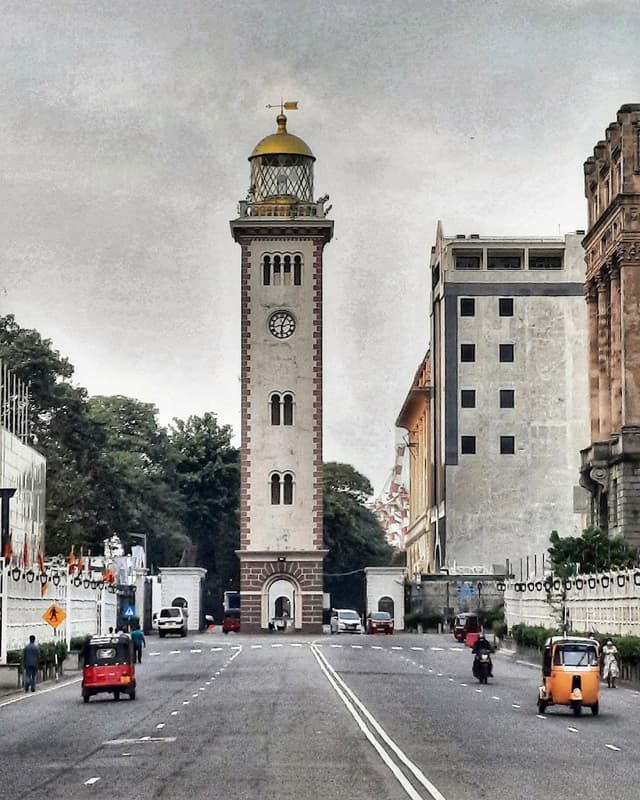
Colombo Fort Old Lighthouse & Clock Tower
@ravinkavish
The **Old Colombo Lighthouse and Clock Tower**, located in the Colombo Fort area, is an iconic historical landmark with a fascinating dual purpose. Built in **1857** during British rule, this 29-meter-tall structure initially served as a lighthouse guiding ships into Colombo's harbor. In **1914**, its light was deactivated as taller buildings obscured its beam, but it continues to function as a clock tower.
Designed by Lady Ward, the wife of Governor Sir Henry Ward, the tower’s neo-classical architecture adds charm to Colombo's bustling financial district. The clock mechanism, made in England, is still operational, making it one of Asia’s oldest clock towers in continuous use.
**Pro tip:** Look out for the engraved royal insignia near the base, and combine your visit with a walk around the Colombo Fort area to discover more colonial-era gems.
Add to
Details

Dutch Hospital - Shopping Precinct
@ravinkavish
The **Dutch Hospital Shopping Precinct**, located in the heart of Colombo, is a beautifully restored colonial building that dates back to the **17th century**. Originally a hospital during Dutch rule, it is considered one of the oldest surviving structures in Colombo. Its thick walls and terracotta roof tiles reflect classic Dutch colonial architecture, seamlessly blending history with modernity.
Today, the precinct is a vibrant hub of activity, housing high-end boutiques, restaurants, and cafes. It’s the perfect spot to shop for souvenirs, indulge in fine dining, or simply relax with a drink in its open-air courtyards. The atmosphere comes alive in the evenings with live music and a lively crowd.
**Pro tip:** Try the local seafood at one of the restaurants, and don’t miss exploring the nearby landmarks like the World Trade Center and Old Colombo Lighthouse. It’s an ideal mix of history, culture, and modern-day leisure.
Add to
Details

Colombo Galbokka Lighthouse
@ravinkavish
Add to
Details

Gangaramaya Temple
@ravinkavish
The Gangaramaya Temple, located near Beira Lake in Colombo, is one of Sri Lanka’s most significant and vibrant Buddhist temples. Established in the late **19th century** by scholar-monk **Hikkaduwe Sri Sumangala Thero**, this temple is not just a place of worship but also a cultural and architectural gem blending traditional, Thai, Indian, and Chinese styles.
The temple complex houses a richly adorned main shrine, a museum showcasing ancient artifacts and gifts from around the world, and a library. Visitors are drawn to its serene ambiance, intricate statues of Buddha, and the sacred Bodhi tree. The temple is also the centerpiece of the annual Navam Perahera, a grand procession celebrated with elephants, dancers, and traditional music.
**Pro tip:** Dress modestly and explore both the temple and nearby Seema Malaka, a floating meditation hall on Beira Lake. It's a peaceful and spiritual escape in the heart of bustling Colombo.
Add to
Details

One Galle Face Mall
@ravinkavish
One Galleface is an ultra-modern mixed-use development located in the heart of Colombo, offering a blend of luxury, commerce, and entertainment. As Sri Lanka's first integrated lifestyle and business complex, it features a stunning 45-story tower that houses high-end offices, residential apartments, a luxury hotel, and a shopping mall. The development is a significant part of Colombo’s skyline, with its sleek design and prime location by the sea.
Visitors to One Galleface can enjoy a wide range of dining, shopping, and entertainment options, with a contemporary mall that houses both international and local brands. The rooftop offers breathtaking views of the Indian Ocean and Colombo’s cityscape, making it a great spot for relaxing or dining with a view.
Pro tip: Visit in the evening to enjoy the vibrant atmosphere, take in the city lights, and experience Colombo's modern side. One Galleface is ideal for travelers looking for a mix of luxury shopping, fine dining, and stunning city views.
Add to
Details

Arcade Independence Square
@ravinkavish
Arcade Independence Square is a popular shopping complex in Colombo. However, this was a renovated building which was a Lunatic Asylum in the beginning when it was constructed in 1889 during the British era 🇬🇧. Later, this was occupied by many government institutions until it was refurbished and opened as an upmarket shopping mall in 2012 due to its prime location. The complex features a variety of shops, from high-end boutiques to local craft stores, and offers numerous dining options, including restaurants and cafes. Located near the Independence Memorial Hall, Arcade Independence Square is known for its serene gardens, water fountains, and open courtyards. It often hosts cultural events and live performances, making it a lively spot for both locals and tourists. With its blend of historical charm and modern amenities, it’s a must-visit destination in Colombo.
Add to
Details

Colombo National Museum
@ravinkavish
The Colombo National Museum is a treasure trove of the island's rich history and cultural heritage. Established in **1877** by Sir William Henry Gregory, then British Governor of Ceylon, the museum is housed in a grand colonial building set amidst a lush, serene garden.
Inside, you’ll find an extensive collection of artifacts ranging from ancient Buddhist sculptures, royal regalia of Sri Lankan kings, traditional masks, and ancient manuscripts. Highlights include the **golden throne of King Wimaladharmasuriya II** and a stunning collection of Kandyan-era crafts. The museum offers an immersive journey into Sri Lanka’s past, spanning over 2,500 years.
**Pro tip:** Allocate at least a couple of hours to explore the galleries. Photography is permitted, but flash is prohibited. After your visit, relax in the museum’s beautiful garden or enjoy nearby cafés. A must-visit for history buffs and culture enthusiasts!
Add to
Details

Colombo Lotus Tower
@ravinkavish
Add to
Details

Viharamahadevi Park
@ravinkavish
Viharamahadevi Park, Colombo’s largest and oldest public park, is a lush green haven amidst the city’s bustling streets. Originally named **Victoria Park** during the British colonial era, it was later renamed in honor of **Queen Viharamahadevi**, a revered figure in Sri Lankan history. The park boasts a rich history, dating back to the late **19th century**, and has been a cherished spot for locals and visitors alike.
The park is adorned with vibrant flower beds, tall palm trees, and tranquil water features, making it a perfect spot for relaxation and picnics. It also features a children’s play area, a mini zoo, and a golden statue of Buddha, adding to its charm. The park often hosts cultural events, making it a lively hub of activity.
**Pro tip:** Visit early in the morning or late afternoon to enjoy the park’s cool breeze. It’s a wonderful place to unwind after exploring Colombo’s landmarks, with attractions like the Colombo Town Hall and National Museum just a short walk away.
Add to
Details
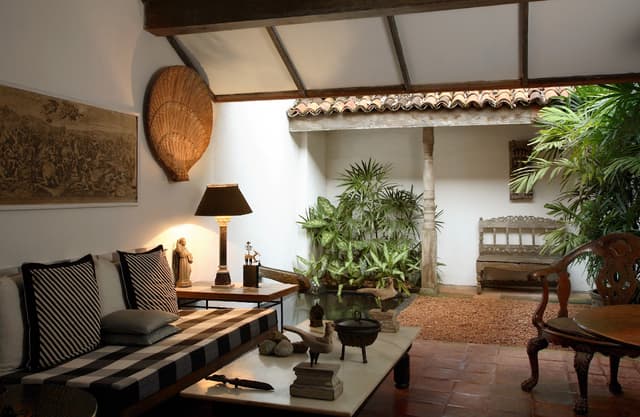
Geoffrey Bawa's Residence
@ravinkavish
Add to
Details

Galle Face Green
@ravinkavish
Galle Face Green is a lively urban park stretching along Colombo’s coastline, offering breathtaking views of the Indian Ocean. Originally laid out in **1859** by Sir Henry Ward, the British Governor of Ceylon, this iconic promenade was once used for horse racing and recreational activities. Today, it’s a favorite gathering spot for locals and travelers alike, renowned for its stunning sunsets and relaxed atmosphere.
The open space is perfect for a leisurely stroll, flying kites, or enjoying street food from vendors selling local favorites like **isso wade** (prawn fritters). Nearby landmarks include the historic Galle Face Hotel and the striking Colombo Lotus Tower, making it a great starting point for exploring the city.
**Pro tip:** Visit in the late afternoon to enjoy the cool sea breeze, try some local snacks, and witness the bustling energy of Colombo’s residents unwinding by the sea.
Add to
Details
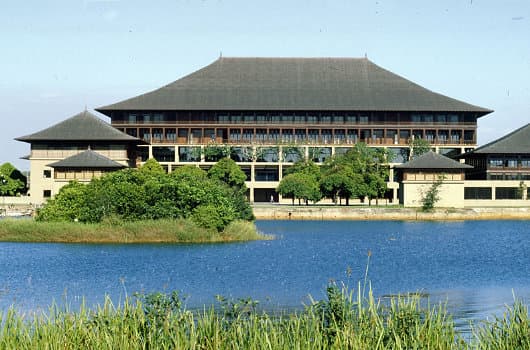
Parliament of Sri Lanka
@ravinkavish
Add to
Details

Maradana Railway Station
@ravinkavish
Add to
Details

Fort Railway station
@ravinkavish
Add to
Details

Presidential Secretariat
@ravinkavish
The **Presidential Secretariat** in Colombo is a grand colonial-era building that serves as the official office of the President of Sri Lanka. Built in **1930**, this iconic structure was originally the General Post Office during British rule. Its neoclassical architecture, characterized by towering columns and intricate details, reflects the grandeur of its historical origins.
Located near the bustling Galle Face Green, the Secretariat holds a significant place in Sri Lanka’s political history and governance. Although access to the building's interior is restricted, its striking façade and the surrounding area make it a popular spot for photography and sightseeing.
**Pro tip:** Combine your visit with a walk along Galle Face Green to enjoy the area’s historical and modern landmarks. The illuminated view of the Secretariat at night adds a touch of elegance to Colombo’s cityscape.
Add to
Details

Dawatagaha Jumma Masjid
@ravinkavish
The Dawatagaha Jumma Masjid, located in Colombo, is a historic and spiritual landmark cherished by the city’s Muslim community. Established in the early **19th century**, this mosque is renowned for its elegant white façade, striking minarets, and serene atmosphere. The mosque also holds a special place as the shrine of **Sheikh Usman Waliyullah**, a revered Sufi saint whose tomb attracts pilgrims seeking blessings and solace.
Nestled in the heart of Colombo, Dawatagaha Masjid is a symbol of the city's multicultural harmony and a peaceful retreat for travelers interested in its rich religious heritage.
**Pro tip:** Visitors are welcome, but be sure to dress modestly and respect the prayer times. The mosque’s intricate architecture and spiritual ambiance make it a unique cultural experience in Colombo.
Add to
Details

Colombo Town Hall
@ravinkavish
The Colombo Town Hall, built in **1928**, is one of the most iconic colonial-era landmarks in the city. Designed in a Neo-Classical style, the building features a grand white façade with towering pillars and a central dome reminiscent of Washington, D.C.’s Capitol building. It was originally constructed to house the administrative offices of the Colombo Municipal Council and still serves that purpose today.
Set amidst the lush greenery of **Viharamahadevi Park**, the Town Hall is a favorite spot for photography and sightseeing. Though the building itself is not open for tours, its majestic exterior and surroundings make it a must-see while exploring Colombo.
**Pro tip:** Visit during the evening when the building is beautifully illuminated. Pair it with a walk through Viharamahadevi Park for a relaxing escape from the city’s hustle and bustle.
Add to
Details

Independence Square
@ravinkavish
Independence Square in Colombo is a historically significant landmark that commemorates Sri Lanka's independence from British rule on February 4, 1948. At its heart lies the Independence Memorial Hall, a grand open pavilion inspired by traditional Kandyan architecture, symbolizing the country’s rich heritage and freedom. The hall is flanked by stone lions and surrounded by lush greenery, offering a peaceful escape within the bustling city.
The site also houses the Independence Memorial Museum, which showcases artifacts and stories from Sri Lanka’s journey to independence. It’s a favorite spot for locals and travelers alike, whether for a leisurely stroll, a jog, or simply soaking in the historical ambiance.
**Pro tip:** Visit in the early morning or evening for cooler weather and vibrant cultural events that sometimes take place here. Independence Square offers a unique mix of history, architecture, and modern-day tranquility.
Add to
Details

Kandy Intercity Bus Station
@ravinkavish
Add to
Details

Dutch Museum
@ravinkavish
Add to
Details

Sri Devram Viharaya Temple
@ravinkavish
Add to
Details

Bellanwila Rajamaha Viharaya
@ravinkavish
Add to
Details

Kandy
@ravinkavish
Kandy, nestled in the lush hill country of Sri Lanka, is a city of deep cultural, historical, and spiritual significance. As the last capital of the ancient Sinhala kings, it played a crucial role in preserving the island’s heritage during colonial times. The city’s crown jewel is the Temple of the Sacred Tooth Relic (Sri Dalada Maligawa), which houses a sacred tooth of the Buddha and is a UNESCO World Heritage Site.
Surrounded by emerald-green hills, Kandy is also known for the picturesque Kandy Lake, which adds to its serene atmosphere. The city comes alive during the annual Esala Perahera, a grand cultural procession featuring elephants, dancers, and drummers that pay homage to the Sacred Tooth Relic.
Beyond its cultural attractions, Kandy offers a gateway to nature, while the Royal Botanical Gardens in Peradeniya showcases a stunning collection of flora. The bustling streets of Kandy are perfect for sampling local delights like Kandyan sweets or shopping for traditional crafts and jewelry.
**Pro tip:** Visit the city in the early morning to explore the Temple of the Tooth before the crowds, and plan a sunset walk around the lake for spectacular views of Kandy’s skyline. Don’t miss the chance to take a scenic train ride to or from Kandy, one of the most beautiful rail journeys in the world.
Add to
Details

Bahirawakanda Temple
@ravinkavish
Add to
Details

Kataragama Devalaya
@ravinkavish
Add to
Details

Ehelepola Walawwa
@ravinkavish
This under-rated site now been used as an administrative office by the Archaeology Department in Rathnapura. This is the "Consorts" Castle of Ehelepola Nilame (1773 – 1829) was a courtier of the Kingdom of Kandy. He was the first Adigar (a role which combined the powers of a prime minister and a chief justice) from 1811 to 1814 under the reign King Sri Vikrama Rajasinha (Last King of the country). He was appointed by the king as the Disawe (local governor) of Sabaragamuva. His Mansion (Walawwa) is separate from this Mansion which is currently the house to Rathnapura Museum. Apart from this he has a separate mansion built in Kandy as well. Not even the King had a structure of this magnitude for his consorts during the Kandyan era. Wooden teak floors and the Architecture resembles the meticulously given details when building the mansion which was housed to the British agents since 1917 after the fall of the Kandyan Kingdom and its ruling provinces to the British Empire.
Add to
Details

St Paul's Church, Kandy
@ravinkavish
St. Paul’s Church in Kandy is a historical Anglican church that stands as a quiet testament to the colonial era and the city’s multicultural heritage. Located adjacent to the Temple of the Sacred Tooth Relic, this charming church offers a fascinating contrast to the Buddhist temples of Kandy while sharing in the spiritual tranquility of the area.
Built between 1843 and 1852, during the British colonial period, St. Paul’s Church served as a place of worship for British officers and residents. Its neo-Gothic architecture, featuring stained glass windows, intricate wooden pews, and a stately bell tower, reflects classic British ecclesiastical designs of the 19th century. The interior is serene and simple, with polished wooden beams and a peaceful ambiance ideal for reflection.
The church is still active today, hosting services and welcoming visitors of all faiths. Its proximity to the Temple of the Sacred Tooth Relic makes it a unique stop for travelers exploring the rich spiritual and cultural tapestry of Kandy.
**Pro tip:** After visiting the church, enjoy a leisurely walk around Kandy Lake, located just across the road, to soak in the serene beauty of the hill capital. Don’t forget to check the service schedule if you’d like to attend a traditional Anglican worship session.
Add to
Details
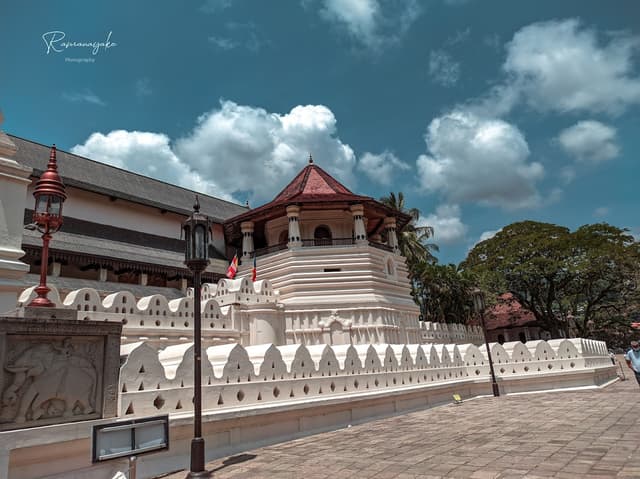
Sri Dalada Maligawa
@ravinkavish
The Sri Dalada Maligawa, or Temple of the Sacred Tooth Relic, is one of the most revered Buddhist sites in the world, located in the heart of **Kandy**. This temple is home to the Tooth Relic of Lord Buddha, an artifact that holds immense spiritual and historical significance to Buddhists in Sri Lanka and around the world. The relic is believed to have been brought to Sri Lanka in the 4th century and has played a key role in the island’s religious and political history.
The temple itself is a stunning example of Kandyan architecture, with intricate wooden carvings, golden embellishments, and beautifully decorated interiors. The Inner Chamber, where the Tooth Relic is kept, is carefully guarded and is only opened during religious ceremonies. Devotees from across the world come to offer their prayers, and special rituals, such as the Dalada Perahera (a grand procession), are held annually in July and August to honor the relic.
The Sri Dalada Maligawa is located near Kandy Lake, which adds to the tranquil and sacred atmosphere of the temple. Visitors can explore the various halls, courtyards, and shrines within the complex, each with its own cultural and historical importance.
**Pro tip:** When visiting, ensure you dress modestly as the temple is a sacred site. Also, consider visiting during the evening for the special puja (prayer) ceremony to witness the religious rituals surrounding the sacred relic.
Add to
Details

Queen's Palace - Madawasala
@ravinkavish
“Medavasala” which is the Queen’s Chamber. Residence of Queen Venkatha Ranga Jammal (Rengammal) the last Queen of the King Sri Wickrama Rajasinghe (1798-1815 AD) who is also the last King of the Kandyan Kingdom before it fell to the hands of the British empire in 1815. The entrance door to the Queen’s chamber exemplifies the exquisite features of the Kandyan period architecture and when the door is closed it can only be opened from the inside as a measure of security. The remains of a Urinal Stone can be seen as well in the chamber right along side her bed. All made of stone and wooden. Wooden pillars consists of rectangular and octangular sections with wood carvings.
Add to
Details
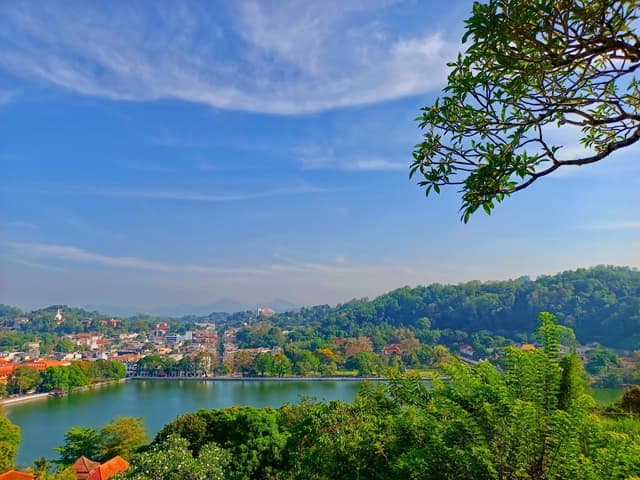
Kandy view point
@ravinkavish
Add to
Details

Gadaladeniya Raja maha viharaya
@ravinkavish
Gadaladeniya Raja Maha Viharaya is a historic Buddhist temple located near Peradeniya in the Kandy District of Sri Lanka. Built in the 14th century, it is renowned for its unique architectural style that combines both Sinhalese and South Indian influences, reflecting the cultural exchanges between Sri Lanka and South India during that era.
The temple was constructed during the reign of King Bhuvanekabahu IV, and it is said to have been designed by a South Indian architect, Godaya, whose influence can be seen in the temple's intricate design. The structure is primarily made of stone and wood, with beautiful carvings and sculptures that showcase the skill of ancient artisans. One of the most notable features is the Vahalkada (porch), with its finely crafted stone pillars and beautiful arches.
The main attraction of the temple is the image house, where a serene statue of Buddha is housed, surrounded by vibrant frescoes depicting the life of the Buddha and other religious themes. The temple also has a stupa (sacred mound), which serves as a focal point for meditation and prayer.
Despite its relatively small size compared to other historical sites in Sri Lanka, Gadaladeniya Raja Maha Viharaya offers a peaceful and serene atmosphere, making it an ideal spot for reflection and exploration of Sri Lanka's rich Buddhist heritage.
**Pro tip:** Visitors to the temple can enjoy the surrounding natural beauty and take a short hike to Lankatilaka Viharaya, another significant temple located nearby, for a full experience of this religious and cultural area.
Add to
Details
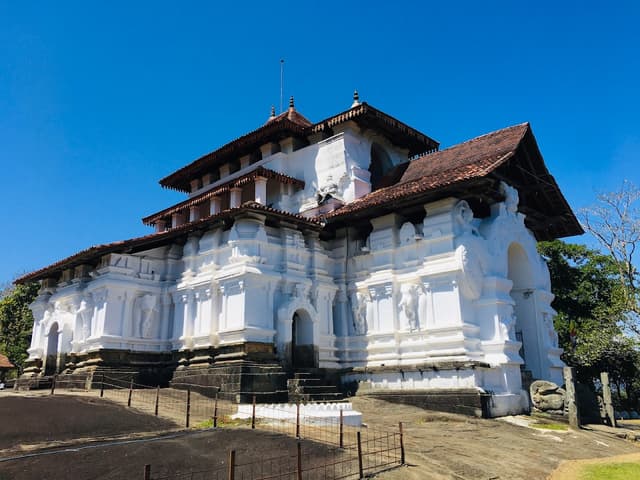
Sri Lankathilake Rajamaha Viharaya
@ravinkavish
Sri Lankathilake Rajamaha Viharaya, located in the historic town of Kandy, is an ancient Buddhist temple rich in history and architectural beauty. This serene temple is known for its impressive structure, which features intricate carvings, a large Buddha statue, and a stunning view of the surrounding hills and countryside. Its peaceful ambiance makes it a great spot for those interested in Sri Lanka’s religious heritage and architectural marvels.
Dating back to the 14th century, Sri Lankathilake Rajamaha Viharaya was built by King Parakramabahu VI and is one of the most significant temples in the region. It is also a great place to learn about Sri Lanka’s rich cultural and spiritual traditions.
**Pro tip:** While visiting the temple, take time to explore the surrounding area, which offers picturesque views and a tranquil atmosphere perfect for reflection and relaxation. The temple is best enjoyed during early morning or late afternoon when the weather is cooler, and the crowds are fewer.
Add to
Details
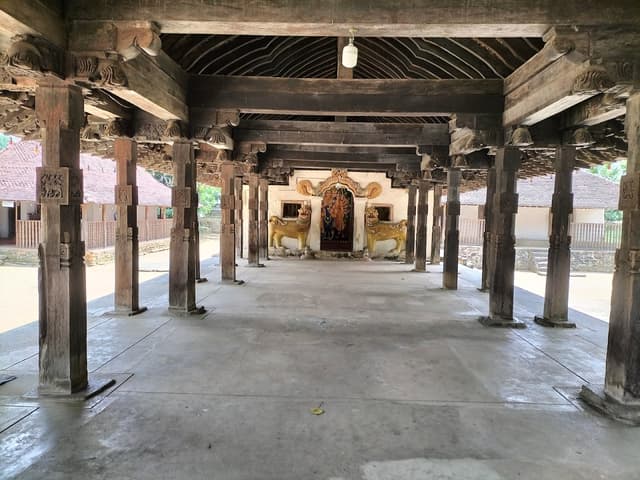
Embekka Dewalaya
@ravinkavish
Embekka Devalaya, located in the quaint village of Embekka near Kandy, is a masterpiece of ancient Sri Lankan woodcraft and cultural heritage. Built during the Gampola Kingdom in the 14th century by King Wickramabahu III, this shrine is dedicated to Kataragama Deviyo, a guardian deity in Sri Lankan tradition.
What makes Embekka truly remarkable is its intricately carved wooden pillars and beams. The carvings depict a variety of fascinating motifs, from floral designs to mythological figures, showcasing the exceptional skill of medieval Sri Lankan artisans. The Hall of Drummers (Digge), with its captivating wooden artistry, is particularly famous and draws admiration from art enthusiasts and travelers alike.
**Pro tip:** Visit during the morning to enjoy the serene atmosphere and the finer details of the woodwork in natural light. Pair your trip with visits to nearby cultural landmarks like Lankatilaka and Gadaladeniya temples for a deeper dive into Sri Lanka's rich history and art.
Add to
Details

Ambuluwawa Tower
@ravinkavish
The Ambuluwawa Tower, perched atop the Ambuluwawa Mountain near Gampola, is one of Sri Lanka's most breathtaking landmarks. This striking tower is part of the Ambuluwawa Biodiversity Complex, inaugurated in 2009 to promote environmental harmony and religious coexistence. The spiral design of the tower is inspired by a Buddhist stupa and symbolizes unity among the island’s diverse cultures and beliefs.
Climbing the tower is an exhilarating experience as the winding staircase narrows at higher altitudes, offering a thrilling ascent. Once at the top, you're rewarded with panoramic views of rolling hills, lush valleys, and distant peaks, including the Knuckles Mountain Range. The complex also features religious shrines representing Buddhism, Hinduism, Islam, and Christianity, emphasizing the area’s inclusive spirit.
**Pro tip:** Arrive early to beat the crowds and enjoy the sunrise, which paints the surrounding landscapes in stunning hues. The ascent can be challenging, so wear comfortable shoes and prepare for strong winds at the peak!
Add to
Details

Dewanagala Rajamaha Viharaya
@ravinkavish
Add to
Details

Sandagiri Maha Seya
@ravinkavish
Add to
Details

Degalldoruwa Raja Maha Viharaya
@ravinkavish
Degalldoruwa Raja Maha Viharaya, nestled in a quiet village near Kandy, is a hidden gem of Sri Lanka's Buddhist heritage. Built during the reign of King Kirti Sri Rajasinha in the 18th century, this temple is famous for its exquisite Kandyan-style murals and rock-hewn architecture, showcasing the artistic and spiritual richness of the era.
The temple is carved directly into a massive rock, creating a natural and serene atmosphere for meditation and worship. Its inner chambers house vividly painted murals depicting scenes from Jataka tales, Buddhist teachings, and local folklore. These frescoes, considered some of the finest examples of Kandyan art, were painted by master artists of the time and are well-preserved, offering visitors a glimpse into Sri Lanka's artistic legacy.
The **Degalldoruwa Stupa**, built atop the rock, adds to the temple's charm, offering panoramic views of the surrounding countryside. Visitors often comment on the peaceful vibe of the site, making it a perfect retreat for those seeking a tranquil and spiritually enriching experience.
**Pro tip:** Combine your visit to Degalldoruwa with a trip to Kandy for a day filled with cultural exploration. Early mornings are ideal to enjoy the temple's serene ambiance without crowds.
Add to
Details

Hindagala Rajamaha Viharaya
@ravinkavish
Add to
Details
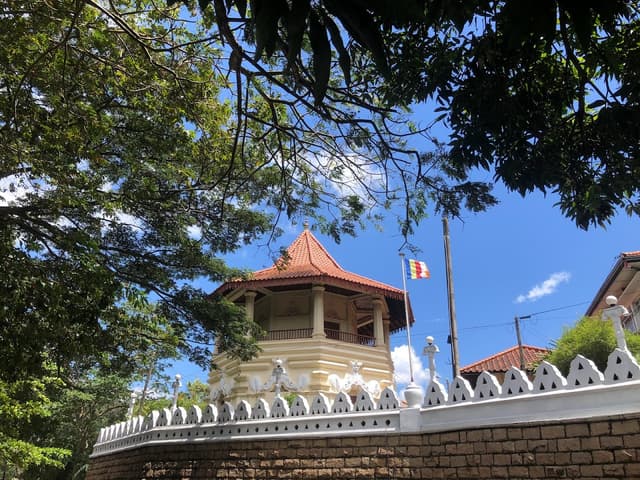
Malwatu Chapter Monastery
@ravinkavish
Add to
Details

Kandy City Centre
@ravinkavish
Add to
Details

Royal Botanic Gardens, Peradeniya
@ravinkavish
The Royal Botanic Gardens, Peradeniya, located just outside the bustling city of Kandy, is one of Sri Lanka's most renowned gardens and a must-visit for nature lovers and travelers. Spanning over 147 acres, this beautifully landscaped garden is home to more than 4,000 species of plants, including tropical and subtropical trees, palms, orchids, and medicinal plants. It offers a peaceful retreat, allowing visitors to immerse themselves in lush greenery while exploring its various themed sections.
The Royal Botanic Gardens have a rich history, dating back to the early 14th century when it was initially established as a royal garden by King Kirthi Sri Rajasinha in the 18th century. However, it was during the British colonial period that the gardens were expanded and modernized, making it one of the finest botanic gardens in Asia.
Among the most notable attractions within the garden is the Avenue of Royal Palms, which creates an impressive entryway, and the Orchid House, which showcases a stunning collection of orchids. There's also the Gingko Biloba Tree, believed to be over 2,000 years old, and the Cannonball Tree, known for its large, round fruits. The garden is also home to a variety of bird species, making it a fantastic spot for birdwatching.
One of the highlights is the Coconut Palm Collection, which is recognized as one of the most diverse in the world, and the Spice Garden, where visitors can learn about Sri Lanka's famous spices like cinnamon, cardamom, and pepper.
For those looking to enjoy a more leisurely experience, there are plenty of shaded paths, large grassy lawns perfect for picnics, and even boat rides on the nearby river.
**Pro tip:** The gardens are a great spot to take a relaxing walk or enjoy a peaceful afternoon picnic. If you're a nature or photography enthusiast, don’t forget your camera to capture the stunning flora and wildlife.
Add to
Details

Hanthana Mountain View Point
@ravinkavish
Add to
Details

Katusu Konda
@ravinkavish
Add to
Details

Teldeniya Old Town
@ravinkavish
Teldeniya Old Town, located near the scenic shores of the Victoria Reservoir, is a place rich in history and nostalgia. Once a bustling administrative hub and a vibrant community, the old town was submerged in the 1980s during the construction of the Victoria Dam, a key part of Sri Lanka’s Mahaweli Development Project. Today, the remnants of Teldeniya’s past remain as an evocative reminder of the sacrifices made for progress.
The new Teldeniya town, established nearby, keeps the memory of the old town alive, with some families still sharing stories of their ancestral homes and lives before the inundation. The area around the former site offers picturesque landscapes, including lush greenery, rolling hills, and the serene waters of the reservoir. It’s a popular spot for nature lovers and photographers.
**Pro tip:** Visit Teldeniya on your way to the Knuckles Mountain Range for a glimpse into Sri Lanka’s natural beauty and a touch of history. Sunrise or sunset around the reservoir provides stunning views that reflect the tranquil beauty of this transformed region.
Add to
Details

Kandy Railway Station
@ravinkavish
Add to
Details

Kandy-Colombo Intercity Bus Station
@ravinkavish
Add to
Details

Kandy Bus Stand
@ravinkavish
Add to
Details

Peradeniya Bus Stand
@ravinkavish
Add to
Details

Kandyan Cultural Centre
@ravinkavish
Highly Recommended for Culture Lovers
Cultural Performances Starts - 5:30 PM
Entrance Fee - 2500
One of the main attractions here is the traditional Kandyan dance performances. These shows are a high-energy mix of drumming, dancing, and acrobatics, featuring intricate costumes and colorful masks. It’s a fantastic way to experience Sri Lankan performing arts up close and feel the rhythm and energy of local traditions.
The center also offers a glimpse into traditional crafts. You can check out local artisans demonstrating their skills in areas like weaving, wood carving, and mask-making. It’s a cool chance to see how these ancient crafts are still practiced today.
The museum section of the center has displays of traditional Sri Lankan artifacts, including costumes, musical instruments, and ceremonial objects. It’s a great spot to learn about the cultural significance of these items and how they were used in ceremonies and daily life.
Overall, the Kandyan Cultural Centre is a vibrant hub for anyone looking to experience and understand the rich cultural heritage of Kandy. It’s lively, educational, and a lot of fun—perfect for getting a deeper dive into Sri Lankan culture.
Add to
Details

Kandy Lake Club - Cultural Dance Show
@ravinkavish
Add to
Details

Nuwara Eliya
@ravinkavish
Nuwara Eliya, often referred to as "Little England," is a charming hill station nestled in the heart of Sri Lanka’s central highlands. Known for its cool climate, colonial-era architecture, and sprawling tea plantations, this picturesque town offers a unique blend of history, natural beauty, and leisure.
The town was established during the British colonial period and became a favorite retreat for the British elite. Today, you can still see colonial-style bungalows, red-brick post offices, and well-maintained gardens. Nuwara Eliya is also famous for its tea culture, and visiting a tea factory to witness the production process is a must. The serene Gregory Lake, lush Hakgala Botanical Garden, and the iconic Horton Plains National Park with the dramatic World's End viewpoint are among the many attractions in the area.
**Pro tip:** Nuwara Eliya is especially magical in April during the flower season and its vibrant horse races. Pack warm clothing as temperatures can drop, especially in the evenings. Don’t miss the chance to indulge in fresh strawberries and a steaming cup of locally grown Ceylon tea while soaking in the breathtaking views.
Add to
Details

Post Office - Nuwara Eliya
@ravinkavish
The Nuwara Eliya Post Office is an iconic landmark in the heart of this charming hill town. Established in 1894 during the British colonial era, this Tudor-style red-brick building stands as a testament to Sri Lanka’s colonial heritage. Its steep roofs, wooden balconies, and vintage charm make it one of the most photographed spots in Nuwara Eliya.
Still functioning as a post office, the building offers a unique opportunity to send postcards to loved ones with a touch of history. It also houses a philatelic bureau, making it a must-visit for stamp collectors and history buffs. The picturesque setting adds to the allure, with the lush gardens and cool mountain air enhancing its timeless appeal.
**Pro tip:** Visit early in the morning to capture the post office in the soft light of the day, and don’t forget to explore other colonial-era gems in Nuwara Eliya like the Grand Hotel and Victoria Park!
Add to
Details

Seetha Amman Kovil
@ravinkavish
Seetha Amman Kovil, located in the lush hills of Nuwara Eliya, is a sacred Hindu temple dedicated to Seetha, the wife of Lord Rama from the ancient Indian epic, the Ramayana. According to legend, this is the place where Seetha was held captive by the demon king Ravana. The temple is a popular pilgrimage site for Hindus and a fascinating stop for travelers interested in Sri Lanka's rich mythological history.
The temple features vibrant carvings of Hindu deities and intricate architecture that reflect traditional South Indian temple design. The serene environment is complemented by the beautiful backdrop of the surrounding mountains and tea plantations. Nearby, a stream runs through the site, and the area is said to have been the place where Seetha bathed during her captivity.
**Pro tip:** Be sure to explore the peaceful surroundings and the nearby Seetha's water stream, said to be where she washed her hair. The temple is especially beautiful during festivals like Diwali and Maha Shivaratri when it is adorned with lights and flowers.
Add to
Details

Victoria Park - Nuwaraeliya
@ravinkavish
Victoria Park in Nuwara Eliya is a beautifully landscaped oasis in the heart of the hill town, offering a perfect escape into nature. Established in 1897 to mark Queen Victoria's Diamond Jubilee, the park spans 27 acres and is home to vibrant flowerbeds, lush lawns, and towering trees. It's a favorite spot for both locals and travelers to relax and enjoy the cool mountain air.
The park is also a birdwatcher’s paradise, hosting species like the Indian Pitta and Pied Thrush. For families, there’s a children’s play area and a small train ride. During the blooming seasons, particularly from March to May and August to September, the park bursts into a riot of colors, making it one of the most photogenic spots in Nuwara Eliya.
**Pro tip:** Visit in the morning for the best light and fewer crowds. Combine your trip with a walk to nearby Gregory Lake for a full day of exploring Nuwara Eliya’s charm. A small entrance fee applies.
Add to
Details

Holy Trinity Church, Nuwara Elia - Church of Ceylon
@ravinkavish
Holy Trinity Church, located in the heart of Nuwara Eliya, is a serene and historic Anglican church built in 1852 during the British colonial era. This quaint stone structure, surrounded by lush greenery, features beautiful stained-glass windows and a peaceful interior that reflects the simplicity and elegance of Gothic Revival architecture.
The church has strong historical significance, having served the colonial community and even being attended by notable figures such as Queen Elizabeth II. Its tranquil atmosphere makes it a lovely spot for reflection, and the adjacent cemetery offers a glimpse into the lives of early settlers in Nuwara Eliya.
**Pro tip:** Don’t miss the original pipe organ, a rare treasure, and the plaques inside that tell stories of the colonial era. Combine your visit with a leisurely stroll through Nuwara Eliya’s Victoria Park for a day steeped in history and natural beauty.
Add to
Details

Swarnagiri Maha Viharaya / Single Tree Temple
@ravinkavish
Swarnagiri Maha Viharaya, also known as the Single Tree Temple, is a peaceful and historically significant Buddhist temple located near Nuwara Eliya. This serene site is believed to have been established centuries ago and is named after the single ancient tree that stands in the temple's courtyard. The tree, thought to be a sacred Bo tree, adds to the spiritual ambiance of the temple, making it a place of meditation and reverence for locals and visitors alike.
The temple itself is modest yet beautiful, with traditional Buddhist architecture and a calm atmosphere. The surrounding area is lush with greenery, and the tranquil environment makes it a perfect spot for reflection. The temple is not as crowded as other tourist spots, offering visitors a peaceful retreat in the midst of Sri Lanka’s hill country.
**Pro tip:** Make sure to take some time to meditate or simply enjoy the quiet surroundings. It’s a great place for a peaceful escape while traveling through Nuwara Eliya.
Add to
Details

Gregory Park
@ravinkavish
Gregory Park, located in the heart of Nuwara Eliya, is a beautifully landscaped recreational area surrounding the tranquil Gregory Lake. Built during the British colonial era by Governor Sir William Gregory in 1873, the park has become a favorite spot for locals and tourists seeking relaxation and outdoor fun. The lush greenery, cool climate, and stunning lake views make it a perfect place to unwind.
The park offers a variety of activities, including boat rides on Gregory Lake, cycling, pony rides, and even family picnics on its well-maintained lawns. Food stalls and cozy cafes around the park serve local treats and refreshments, adding to the charm of this serene location.
**Pro tip:** Visit Gregory Park in the late afternoon to enjoy a leisurely walk or boat ride as the sun sets over the hills. The park is especially vibrant during the April season when flowers bloom, and festive events are held. It's an ideal spot for photography and spending quality time with family or friends in the cool mountain air.
Add to
Details

Hakgala Botanical Garden
@ravinkavish
Hakgala Botanical Garden, located about 10 kilometers from Nuwara Eliya, is a stunning haven of flora and one of the largest botanical gardens in Sri Lanka. Nestled at the foot of the Hakgala Rock, this garden is perched at an elevation of nearly 5,400 feet, making it the highest in the country. Established in 1861 during the British colonial era, it initially served as a cinchona plantation before transitioning into a botanical garden featuring a remarkable collection of plants.
The garden boasts a diverse range of temperate and subtropical flora, including vibrant roses, colorful orchids, towering cedars, and rare ferns. It is divided into several sections, such as the rose garden, fernery, and rock garden, each offering a unique charm. Legend connects the site to the Ramayana, as the location where Hanuman brought a part of the Himalayas to Sri Lanka to heal Lakshmana.
**Pro tip:** Visit during spring or summer to see the garden in full bloom. Take your time wandering through its serene pathways, enjoying the cool mountain air and picturesque scenery. This is a peaceful retreat for nature enthusiasts, photographers, and those seeking tranquility amidst the beauty of the highlands.
Add to
Details

Bomburu Ella Waterfall
@ravinkavish
Bomburu Ella Waterfall, also known as the "Ramboda Falls," is one of the most breathtaking and majestic waterfalls in Sri Lanka, located near the Ramboda Pass in the central highlands. The waterfall drops over 50 meters, cascading down in multiple tiers, creating a mesmerizing view of the surrounding forested hills. Its pristine, unspoiled environment and the cool mist rising from the water make it a must-visit for nature lovers and photographers.
The waterfall is easily accessible via a short trek from the main road, passing through a tea plantation and lush greenery. The surrounding area is rich in biodiversity, with various species of plants and birds adding to the appeal of the hike. The site offers a tranquil escape from the hustle and bustle of city life.
**Pro tip:** Visit during the monsoon season (April to October) to witness the waterfall in its full glory with powerful water flow. Don’t forget to take a dip in the cool, refreshing waters at the base of the falls for a truly invigorating experience.
Add to
Details
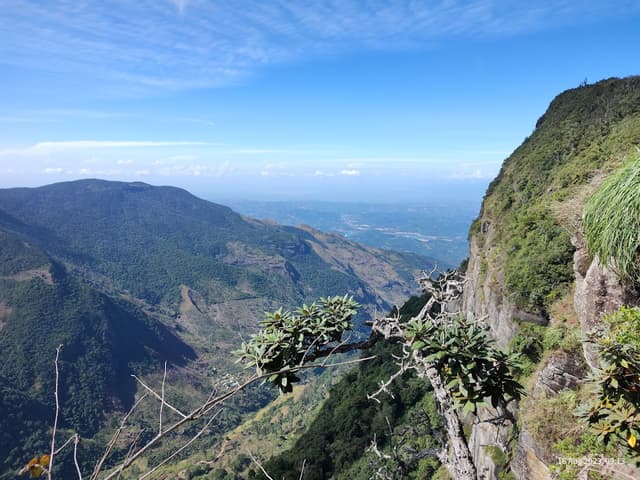
Horton Plains National Park
@ravinkavish
Horton Plains National Park, located in the central highlands of Sri Lanka, is a UNESCO World Heritage site renowned for its breathtaking landscapes, diverse wildlife, and unique ecosystem. The park is situated at an altitude of 2,100 to 2,300 meters (6,890 to 7,550 feet) above sea level, and it covers an area of around 3,160 hectares.
One of the park's main attractions is **World’s End**, a sheer cliff that drops dramatically for about 870 meters (2,850 feet), offering a stunning panoramic view of the surrounding valleys, forests, and distant hills. The **mini World's End**, located not far from the main viewpoint, provides another striking view and is a popular stop for hikers.
The park is home to a variety of flora and fauna, including endemic species such as the **Sri Lankan leopard**, **purple-faced langur**, and the **sambar deer**. Birdwatchers will find Horton Plains a haven, as it is home to numerous species like the **Sri Lanka bush warbler** and **yellow-eared bulbul**. The park also has a range of plant life, including montane grasslands, cloud forests, and heathlands, which support a variety of unique and rare plant species.
Visitors to Horton Plains can enjoy a scenic **trek** that takes them through the park's diverse environments, with highlights such as the **Baker's Falls**, a beautiful waterfall located within the park, and the various viewpoints that offer incredible vistas. The trail is approximately 9 kilometers (5.5 miles) long and takes about 3-4 hours to complete, making it a moderate hike suitable for most visitors.
Horton Plains is a great destination for nature lovers, wildlife enthusiasts, and trekkers, offering an immersive experience in one of Sri Lanka's most ecologically rich and scenic areas.
Add to
Details
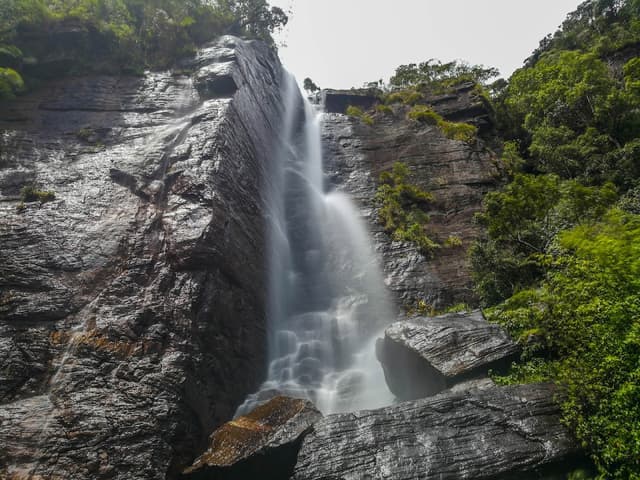
Lover's Leap Waterfall
@ravinkavish
Lover’s Leap Waterfall, a hidden gem near Nuwara Eliya, is a stunning cascade that plunges 30 meters down a rocky cliff surrounded by lush greenery. Named after a local legend of a tragic love story, this waterfall is not only a scenic spot but also steeped in romance and mystery. The water originates from the clear streams of Pidurutalagala, Sri Lanka’s tallest mountain, making it a pristine and refreshing sight.
A short trek through tea plantations leads you to the falls, offering picturesque views of the surrounding landscape along the way. The sound of rushing water and the cool misty breeze make it a serene escape for nature lovers and adventure seekers alike.
**Pro tip:** Visit during the rainy season (November to March) for the best water flow. Pair your visit with a tour of a nearby tea estate for an authentic hill-country experience.
Add to
Details

Nanuoya Railway Station
@ravinkavish
Add to
Details

Magasthota Junction
@ravinkavish
Add to
Details

Haputale
@ravinkavish
Haputale, a serene hill town perched at an elevation of around **1,431 meters**, offers some of Sri Lanka's most breathtaking views. Nestled in the central highlands, it is a haven for tea lovers, nature enthusiasts, and anyone seeking a peaceful escape. With its cool climate, lush tea plantations, and mist-draped landscapes, Haputale exudes an unhurried charm.
One of the highlights of Haputale is **Lipton’s Seat**, the favorite viewpoint of Sir Thomas Lipton, who revolutionized tea production in the region. The panoramic view from this spot stretches across verdant valleys and distant peaks. The nearby **Dambatenne Tea Factory**, established by Lipton himself, provides insight into the tea-making process.
Other must-visit attractions include **Adisham Bungalow**, a picturesque Benedictine monastery, and the tranquil **Thangamale Sanctuary**, ideal for birdwatching and short hikes. Haputale is also a gateway to **Horton Plains National Park** and the iconic **World’s End**.
**Pro tip:** Early mornings are the best time to explore, as the mist rolls in by afternoon, adding a mystical feel to the surroundings. Don’t forget a camera to capture the dramatic landscapes!
Add to
Details

Adisham Bungalow (St.Benedict's Monastery)
@ravinkavish
Adisham Bungalow, also known as **St. Benedict's Monastery**, is a beautiful colonial-era estate located in the hills of **Haputale**, Sri Lanka. This peaceful retreat, surrounded by scenic views of lush forests, tea plantations, and rolling hills, is a popular stop for travelers exploring the central highlands.
Built in 1931 by Sir Thomas Lister Villiers, a British planter, Adisham Bungalow was originally his private residence. The bungalow’s design is inspired by English country homes, with beautiful brickwork, large windows, and a charming veranda that overlooks the surrounding landscape. Today, it serves as a monastery for Benedictine monks, who have maintained the property and its tranquil ambiance.
The place is well-known for its serene atmosphere and scenic beauty, with the gardens around the bungalow offering a perfect spot for a leisurely stroll. The monastery itself is a peaceful place of reflection, and visitors are welcome to explore the property, though it’s important to respect the peaceful environment and the monks who live there.
**Pro tip:** Don’t miss the chance to walk through the surrounding tea estates, as the area is known for its beautiful plantations and cool, misty climate. It’s also worth noting that there is a small chapel on the property where visitors can quietly reflect. For the best experience, visit early in the morning or late afternoon to enjoy the serene atmosphere without the crowds.
Add to
Details
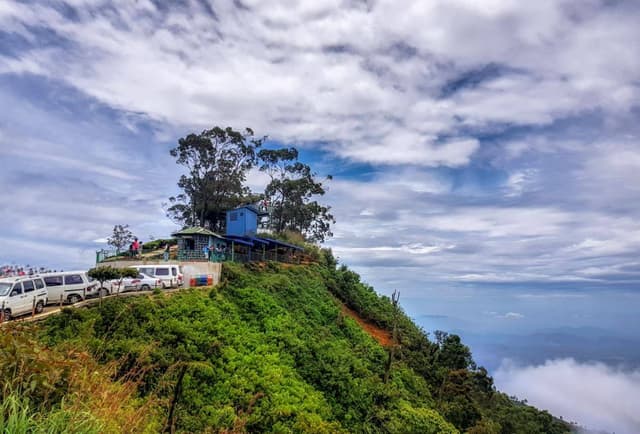
Lipton's Seat
@ravinkavish
Lipton's Seat, perched high in the hills of Haputale, offers one of the most breathtaking panoramic views in Sri Lanka. This iconic viewpoint, named after Sir Thomas Lipton, the famous tea planter, provides a stunning 360-degree vista of rolling tea plantations, misty mountains, and distant valleys. Whether you choose to hike or take a scooter ride, the journey to Lipton’s Seat is an adventure in itself, with the scenic route winding through lush tea estates and dense forests.
The trek or ride up to the viewpoint is around 7 kilometers from the nearest main road, and the cool, fresh air and mesmerizing landscapes make the effort worthwhile. The location is perfect for photography, picnics, or simply soaking in the beauty of Sri Lanka’s hill country.
**Pro tip:** The best time to visit is early in the morning or late afternoon when the mist clears, offering incredible views of the surrounding landscape. If you're driving, take a scooter for a more adventurous route, or opt for a hike if you enjoy a more peaceful, nature-filled experience. Lipton's Seat is a must-visit for anyone exploring Sri Lanka’s tea country.
Add to
Details

Ellewala Waterfall
@ravinkavish
Ellewala Waterfall, located near Wellawaya in Sri Lanka’s beautiful hill country, is a stunning, serene waterfall perfect for nature lovers seeking a peaceful escape. This 30-meter waterfall cascades down a rocky cliff, surrounded by lush greenery and dense forest. The waterfall’s tranquil pool at the base is ideal for a refreshing swim, especially in the dry months from December to March when the flow is gentler and safer for a dip.
To reach Ellewala, visitors can enjoy a short trek through picturesque tea plantations and forest paths, making it an excellent destination for hiking and photography. The natural beauty of the area provides a perfect backdrop for a peaceful retreat or picnic.
**Pro tip:** The best time to visit is from **December to March**, when the weather is dry, and the water flow is more inviting. Avoid visiting during **May** and **October**, which are typically the wettest months in the hill country and can result in stronger currents and slippery paths. If you’re in the Wellawaya area, don’t miss this hidden gem of nature!
Add to
Details

Upper Diyaluma Trek Start
@ravinkavish
Add to
Details

Upper Diyaluma Waterfall
@ravinkavish
Add to
Details

Pilkington Point
@ravinkavish
Pilkington Point, located in the picturesque hills of Haputale, is a serene viewpoint that offers breathtaking panoramas of Sri Lanka’s southern plains. Named after a British colonial planter, this spot was historically a favorite retreat for those seeking to immerse themselves in nature’s beauty. From here, you can see lush tea plantations, rolling valleys, and distant mountain ranges stretching all the way to the southern coastline on a clear day.
Accessible via a short and scenic drive or hike through tea estates, Pilkington Point provides a tranquil escape, perfect for photography, picnics, or simply soaking in the fresh mountain air. Its elevation and peaceful surroundings make it a hidden gem for those exploring Haputale.
**Pro tip:** Visit during the early morning or late afternoon for the best lighting and clearer views. Pair this experience with a trip to other Haputale highlights like Lipton’s Seat or the Dambatenne Tea Factory for a full day of exploration in the hill country.
Add to
Details

Railway Station Haputale
@ravinkavish
Add to
Details
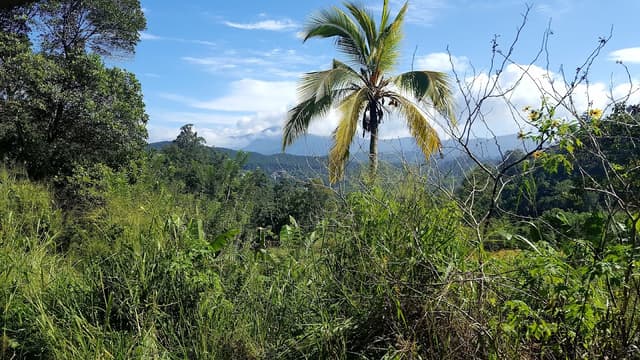
Ella
@ravinkavish
Ella, a charming village in Sri Lanka's hill country, is a paradise for travelers seeking stunning views, outdoor adventures, and a laid-back vibe. Surrounded by misty mountains, lush tea plantations, and cascading waterfalls, Ella offers a perfect blend of natural beauty and cultural richness.
The iconic **Nine Arches Bridge**, a colonial-era marvel, is a favorite spot for photography, especially when the train winds its way through the lush greenery. The trek to **Ella Rock** rewards you with panoramic views, while the shorter climb up **Little Adam’s Peak** is perfect for beginners, offering equally mesmerizing vistas.
Ella is also a hub for tea lovers. Visit the **Halpewatte Tea Factory** to learn about Sri Lanka’s world-renowned tea industry. For history enthusiasts, the nearby **Ravana Ella Falls** and **Ravana Cave** are linked to the epic Ramayana, adding a touch of mythology to your journey.
**Pro tip:** Plan your hike early in the morning for the best weather and views. Afterward, relax with a cup of locally grown tea or enjoy the lively cafes and restaurants that line the streets of Ella town.
Add to
Details

Dowa Ancient Temple
@ravinkavish
Dowa Ancient Rock Temple, located in the **Badulla District** of Sri Lanka, is a fascinating historical and religious site that offers a unique blend of natural beauty and cultural heritage. The temple is built into a massive rock face, providing visitors with a sense of awe as they approach. Known for its stunning **rock carvings**, the Dowa Temple dates back to the 2nd century BC and holds significant importance in Sri Lanka's Buddhist history.
The main attraction at Dowa Ancient Rock Temple is the **large reclining Buddha statue**, which is carved into the rock. This statue is believed to have been created during the Anuradhapura period, and it stands as a testament to the skill and devotion of the artists of that time. In addition to the Buddha statue, the temple complex also features other smaller Buddha figures, intricate rock carvings, and ancient inscriptions that offer insight into the history of Buddhism in Sri Lanka.
The best time to visit Dowa Ancient Rock Temple is during the **dry season**, from **December to March**, when the weather is comfortable for exploring and hiking around the temple. The months of **May** and **October** are generally wetter and could make the trails slippery and harder to navigate.
**Pro tip:** The hike up to the temple involves a short climb, but the views from the top of the rock are well worth the effort. Take your time to explore the rock carvings and inscriptions, and don’t forget to take a moment to appreciate the peaceful atmosphere and the scenic surroundings.
Add to
Details

Blue Water Cave Pond (Nil Diya Pokuna)
@ravinkavish
Blue Water Cave Pond (Nil Diya Pokuna), located in the Knuckles Mountain Range, is a hidden gem surrounded by dense forest and rugged terrain. This crystal-clear pond, nestled in a serene cave, is known for its striking blue water, which gives it the name "Nil Diya Pokuna," meaning "Blue Water Pond." The water, fed by natural springs, remains cool and refreshing throughout the year, creating a peaceful environment for visitors.
The journey to Nil Diya Pokuna requires a moderate hike through the forest, making it an excellent destination for nature lovers and those seeking an off-the-beaten-path adventure. The pond itself is tranquil and offers a mesmerizing view of the surrounding greenery. It's also a great spot for photography, as the vibrant blue water contrasts beautifully with the lush vegetation and rocks.
The best time to visit Nil Diya Pokuna is during the **dry season**, from **December to March**, when the weather is more stable, and the path to the cave is easier to navigate. **May** and **October** can be challenging, as the rainy season can make the trail slippery and difficult to hike.
**Pro tip:** Since the area is remote and not as developed for tourism, it’s advisable to bring plenty of water, wear sturdy footwear, and be prepared for a hike through a forested trail. This serene spot is perfect for those looking to escape the crowds and experience the natural beauty of Sri Lanka's hill country.
Add to
Details

Nine Arches Bridge
@ravinkavish
Nine Arches Bridge is one of Sri Lanka’s most iconic landmarks, located near the town of Ella in the central highlands. Built during the British colonial era in the 1920s, this stunning bridge spans a deep valley surrounded by lush greenery and tea plantations. The bridge is 91 meters long and stands at 24 meters above the ground, with nine graceful arches giving it its name.
The Nine Arches Bridge is a marvel of engineering and has become a popular spot for both tourists and photographers, offering breathtaking views of the surrounding hills and valleys. The bridge is located along the railway line that connects Kandy to Badulla, and it’s a popular spot for watching the famous trains that pass through, creating a perfect photo opportunity.
The best time to visit Nine Arches Bridge is during the **dry season** from **December to March**, when the weather is stable and clear, offering perfect visibility for photography. **May** and **October** can bring heavy rainfall, which may make the area slippery and affect visibility.
**Pro tip:** The best views of the bridge can be captured from the nearby hills, which are easily accessible by a short hike. If you want to catch a train crossing the bridge, check the train schedule ahead of time, as it’s a popular spot for train enthusiasts and photographers.
Add to
Details

Kombukara Nature Pool and Secret Waterfall
@ravinkavish
Add to
Details
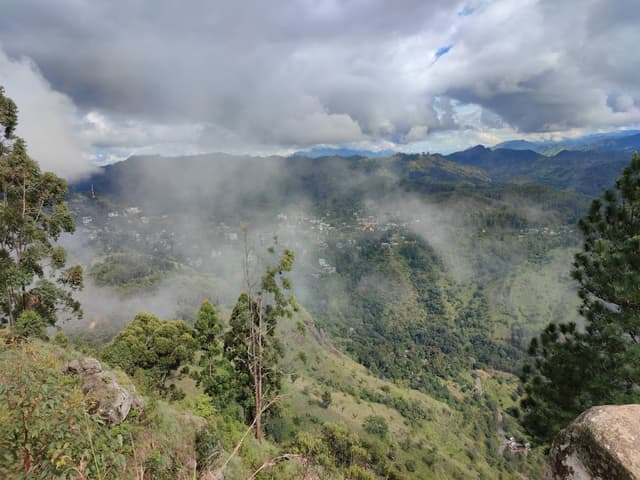
Ella Rock Trailhead
@ravinkavish
Add to
Details

Little Adam's Peak Trailhead
@ravinkavish
Add to
Details

Bulugala Arannaya (Bulugala Monastery)
@ravinkavish
Add to
Details

Uva Halpewatte Tea Factory Tour
@ravinkavish
Add to
Details

Ella Railway Station
@ravinkavish
Add to
Details

Flying Ravana Mega Zipline
@ravinkavish
Add to
Details
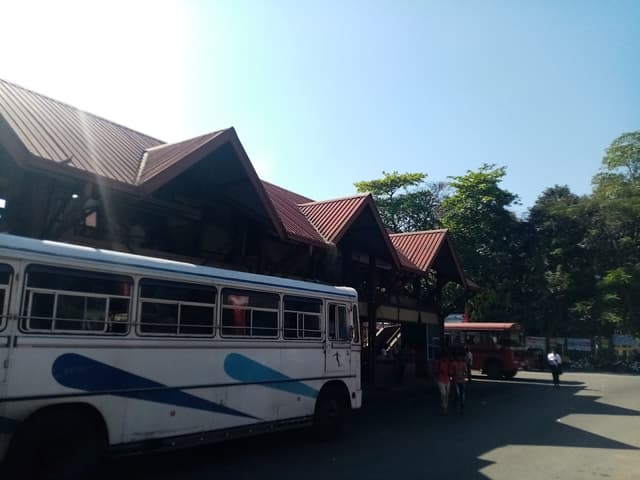
Wellawaya Bus Stop to Arugambay
@ravinkavish
Add to
Details

Kotaweheragala Bus stop
@ravinkavish
Add to
Details
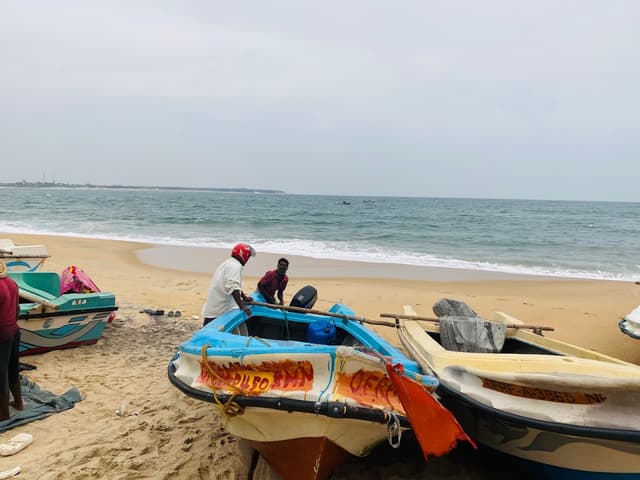
Arugam Bay
@ravinkavish
Add to
Details

Mani Naga Pabbatha Raja maha Viharaya, Sastrawela, Panama
@ravinkavish
Add to
Details

Elephant Rock
@ravinkavish
Add to
Details

Lahugala Magul Maha Viharaya
@ravinkavish
Add to
Details

Kotawehera Ancient Temple
@ravinkavish
Add to
Details

Panama Wewevehera Rajamaha Viharaya
@ravinkavish
Add to
Details

Veherakama Buddhist Ruins
@ravinkavish
Add to
Details

Kunukola Lagoon Buddhist Viharaya
@ravinkavish
Add to
Details

Kudumbigala Monastery Complex
@ravinkavish
Add to
Details

Sangamankanda Lighthouse
@ravinkavish
Add to
Details

Rakkiththa Kanda Rajamaha Viharaya
@ravinkavish
Add to
Details

Kumana National Park
@ravinkavish
Add to
Details
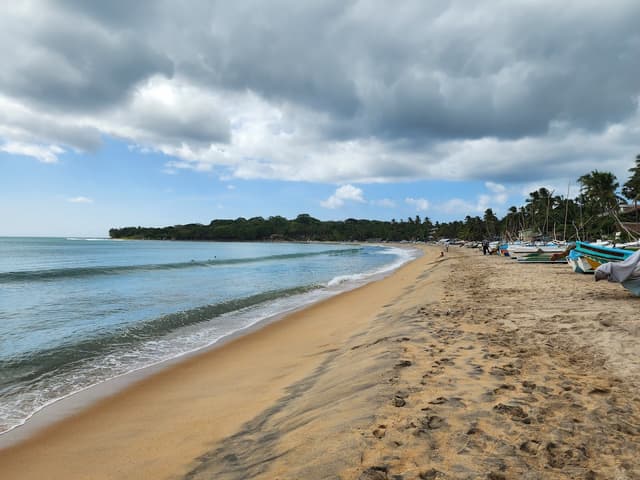
Arugam Bay Beach
@ravinkavish
Add to
Details

Pottuvil point
@ravinkavish
Add to
Details

Lagoon Elephant View Point
@ravinkavish
Add to
Details

Crocodile Rock
@ravinkavish
Add to
Details

Peanut Farm Beach
@ravinkavish
Add to
Details

Panama Beach
@ravinkavish
Add to
Details
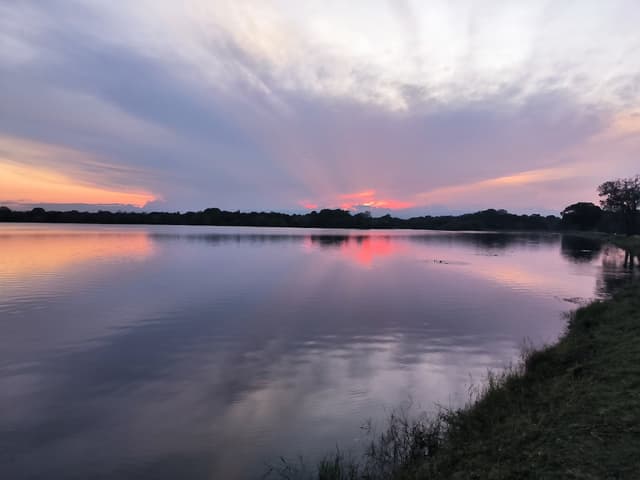
Panama Wewa/Lake
@ravinkavish
Add to
Details

Pottuvil Bus Stand
@ravinkavish
Add to
Details

Akkaraipattu Bus Stop to Habarana
@ravinkavish
Add to
Details

Sigiriya Town
@ravinkavish
Sigiriya Town, located in the heart of Sri Lanka's cultural triangle, is a charming and vibrant destination with much to offer. Famous for the iconic Sigiriya Rock Fortress, this town is a hub for history, culture, and nature. Sigiriya is a UNESCO World Heritage Site and attracts travelers with its ancient ruins, beautiful gardens, and panoramic views from the top of the rock.
The town itself is peaceful, with plenty of accommodation options, local markets, and eateries offering traditional Sri Lankan cuisine. Sigiriya is also surrounded by lush forests, tranquil lakes, and smaller sites like the Pidurangala Rock, providing visitors with plenty of opportunities for exploration.
**Pro tip:** Visit early in the morning or late afternoon to avoid crowds at Sigiriya Rock and enjoy cooler weather. If you have extra time, explore nearby sites like the ancient city of Polonnaruwa or Minneriya National Park for a full cultural and natural experience. Sigiriya Town is the perfect base for adventurers and history buffs alike.
Add to
Details

Sigiriya Lion Rock
@ravinkavish
Sigiriya Lion Rock, one of Sri Lanka's most iconic landmarks, is a must-visit destination for history and nature lovers alike. This ancient rock fortress rises 200 meters above the surrounding jungle and offers breathtaking panoramic views from the top. Sigiriya is renowned for its impressive architecture, frescoes, and the giant lion's paws that once guarded the entrance to the summit.
The fortress dates back to the 5th century AD, built by King Kashyapa as a royal palace and fortress. As you ascend the rock, you’ll pass through lush gardens, ancient water features, and well-preserved frescoes that depict celestial maidens. The climb to the top is a bit challenging but rewarding, with stunning views of the surrounding landscapes and the nearby Pidurangala Rock.
**Pro tip:** Arrive early to avoid the midday heat and crowds. The best time for a visit is during the early morning or late afternoon when the light creates perfect conditions for photography. Sigiriya Lion Rock is a UNESCO World Heritage site, offering a fascinating blend of history, culture, and natural beauty.
Add to
Details

Pidurangala Royal Cave Temple
@ravinkavish
idurangala rock cave temple and it’s surrounding consists of the “panchavasa “ 5 main ritual buildings. Which is Ancient Stupa,Chapter House, Image House , Bodhigara , Preaching Hall, Sangarama ( resident of monks) and inscriptions with drip ledged caves can be seen. Goes back to the 1 and 2 century BC. During the reign of King Kashyapa (473-495 AC) the Architect behind the Historical Sigiriya rock frescoes this temple was used as a Buddhist Monastery. Situated few kilometers North of the historical fort Sigiriya.
Add to
Details
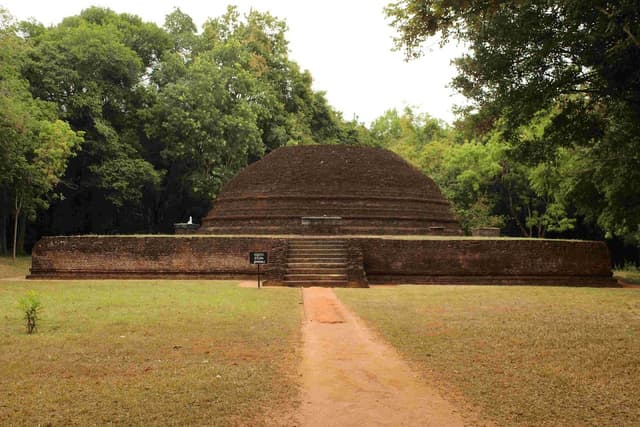
Pidurangala Old Dageba
@ravinkavish
Add to
Details

Pidurangala Rock
@ravinkavish
Pidurangala Rock is a stunning natural landmark located just a few kilometers from the iconic Sigiriya Lion Rock. Known for its panoramic views, Pidurangala offers a less crowded alternative to its famous neighbor while still delivering breathtaking vistas of the Sigiriya Rock Fortress and the surrounding jungle.
The climb to the top is an adventurous one, taking you through a mix of jungle paths, boulders, and rock ledges. Along the way, you'll encounter a small Buddhist temple, adding a touch of history and spirituality to the hike. The summit of Pidurangala provides sweeping views of Sigiriya, the surrounding countryside, and distant mountain ranges—an excellent spot for sunrise or sunset.
**Pro tip:** The hike up Pidurangala Rock is shorter but steeper than Sigiriya, and it's much quieter, allowing for a more peaceful experience. To get the best views of Sigiriya, climb early in the morning or late in the afternoon. Pidurangala is the perfect destination for those looking to enjoy both nature and history without the crowds.
Add to
Details

Little Pidurangala
@ravinkavish
Little Pidurangala, also known as Mapagala, is a hidden gem just 750 meters from Sigiriya Rock, offering a quieter and equally stunning alternative. This ancient site, once a part of King Kashyapa's defensive fortifications, is a fascinating mix of history and nature. The climb is shorter than Pidurangala, making it perfect for those seeking a less strenuous adventure.
At the summit, you’ll be rewarded with unobstructed views of Sigiriya Rock rising majestically above the lush jungle—a photographer’s dream. The area feels untouched, with fewer crowds, giving it a peaceful and almost secret vibe.
Pro tip: Visit during sunrise or sunset for the most magical views. Little Pidurangala is perfect for travelers who love off-the-beaten-path experiences with a touch of history and breathtaking scenery.
Add to
Details

Kalawewa National Park
@ravinkavish
Kalawewa National Park, located in the North Central Province of Sri Lanka, is a serene and lesser-known gem for nature lovers and wildlife enthusiasts. The park surrounds the Kalawewa Reservoir, one of the oldest and largest irrigation tanks in Sri Lanka, which was originally constructed by King Dhatusena in the 5th century CE.
The park is home to a diverse range of flora and fauna, including a variety of birds, mammals, and reptiles. The reservoir itself attracts numerous bird species, particularly during migratory seasons, making it a prime spot for birdwatching. The park is also known for its elephant population, which can often be spotted around the reservoir and in the surrounding forested areas. Other wildlife includes deer, wild boar, and a range of smaller animals like monkeys and lizards.
The Kalawewa Reservoir plays a crucial role in the local ecosystem and has become a hub for fishing, boating, and peaceful retreats. It’s an ideal location for those seeking a more tranquil experience compared to other more heavily visited parks.
**Pro tip:** The park is not as crowded as some other national parks in Sri Lanka, providing a more peaceful experience. Early mornings or late afternoons offer the best chances for wildlife sightings. You can also enjoy a boat ride on the reservoir, which gives you a chance to spot birds and enjoy the beauty of the surrounding landscape.
Add to
Details

Minneriya National Park
@ravinkavish
Minneriya National Park is a wildlife hotspot, famous for hosting the world-renowned "Elephant Gathering," where hundreds of elephants gather around the Minneriya Tank during the dry season (July to October). It's one of the best places in Sri Lanka to see wild elephants in their natural habitat. Along with elephants, you might encounter toque macaques, sambar deer, and even crocodiles lurking near the water. The park is also home to colorful bird species like kingfishers and painted storks.
Pro tip: An afternoon safari offers the best chance to see elephants and other wildlife as they come to the tank to drink. The park’s open landscapes and forest patches create the perfect setting for unforgettable wildlife sightings and stunning sunset views.
Add to
Details

Polonnaruwa Ancient City/ entrance to a collection of ancient sites
@ravinkavish
Polonnaruwa Ancient City, a UNESCO World Heritage site, is one of Sri Lanka’s most significant historical landmarks, offering a fascinating glimpse into the country’s rich cultural and architectural heritage. Once the capital of Sri Lanka from the 11th to 13th centuries, Polonnaruwa is renowned for its well-preserved ruins and ancient structures, which include palaces, temples, and stupas.
The city flourished under the reign of King Parakramabahu I, who is credited with expanding and beautifying the city, as well as building extensive irrigation systems that transformed the area into a prosperous hub. Key highlights of the city include the remarkable *Gal Vihara* rock temple with its stunning Buddha statues, the majestic *Rankoth Vehera* stupa, and the *Royal Palace* ruins. The *Parakrama Samudra*, an ancient man-made reservoir, is also a notable feature of the site, reflecting the advanced engineering of the time.
**Pro tip:** The ancient city is spread over a large area, so it’s recommended to either rent a bicycle or hire a guide to help explore the key sites. It’s also a great place for photography, especially at sunrise or sunset, when the lighting enhances the beauty of the ruins. Take time to appreciate the historical significance of the city and the legacy of the ancient Sri Lankan kings who once ruled from this magnificent capital.
Add to
Details

Kalawewa National Park Camping point
@ravinkavish
Add to
Details

Kalawewa Kayaking
@ravinkavish
Kalawewa Kayaking is a tranquil adventure that takes you across the historic waters of the Kalawewa Reservoir, built in the 5th century by King Dhatusena. This engineering marvel, part of an ancient irrigation network, still nourishes the surrounding landscapes. As you paddle through its calm waters, you’ll feel a connection to Sri Lanka’s rich history while enjoying breathtaking views, including the towering Avukana Buddha statue nearby.
Wildlife adds to the magic—spot herds of giant elephants grazing near the banks, water buffalo cooling off, and crocodiles basking in the sun. Bird enthusiasts can look out for pelicans, herons, and kingfishers gliding above.
Pro tip: Early mornings or late afternoons are ideal for kayaking, offering cooler weather, peaceful vibes, and the best chances for wildlife sightings. Kalawewa combines adventure, natural beauty, and a deep sense of history, making it an unforgettable experience for any traveler.
Add to
Details

Habarana junction Bus Stop ( Trincomalee /Muthur/Pulmude)
@ravinkavish
Add to
Details
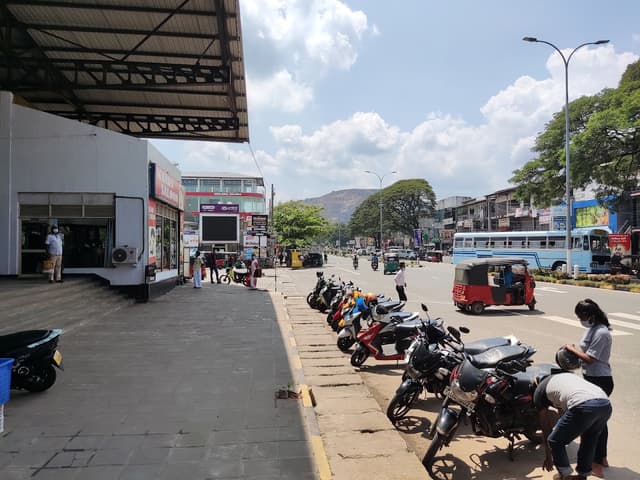
Dambulla Bus Stand
@ravinkavish
Add to
Details

Dambulla Bus Stop ton Anuradhapura
@ravinkavish
Add to
Details

Anuradhapura
@ravinkavish
Anuradhapura, one of Sri Lanka's most iconic ancient cities, is a UNESCO World Heritage Site and the heart of the island's rich cultural and spiritual heritage. Established in the 4th century BCE, it served as the capital of Sri Lanka for over 1,300 years, showcasing a golden era of art, architecture, and Buddhism.
The city is famed for its sprawling ruins, including majestic stupas like **Ruwanwelisaya** and **Jetavanaramaya**, ancient monasteries, and sacred sites like the **Sri Maha Bodhi**, a revered fig tree believed to be the oldest living tree planted by humans, dating back to 288 BCE. The irrigation marvels, including massive tanks like **Tissa Wewa**, reflect the advanced engineering skills of its ancient inhabitants.
**Pro tip:** Explore Anuradhapura by bicycle or tuk-tuk to fully immerse yourself in its historical grandeur. Don't miss sunrise or sunset at one of the stupas, where the golden light enhances the mystical aura of this ancient city.
Add to
Details

Ruwanweli Maha Seya
@ravinkavish
Ruwanweliseya, also known as the Great Stupa, is an awe-inspiring ancient monument located in Anuradhapura, Sri Lanka. Dating back to 140 BC, this majestic structure is one of the tallest ancient monuments in the world, standing at approximately 103 meters (338 feet) with a circumference of 290 meters (951 feet). It is considered one of the supreme living monuments, alongside the Temple of the Tooth in Kandy, and is a UNESCO World Heritage Site. The stupa was originally built by King Dutugemunu (161-137 BC), who dedicated it to housing two quarters of the sacred relics of Lord Buddha. The construction was completed by his brother, King Saddhatissa, who ascended the throne after Dutugemunu's untimely death. Ruwanweliseya is renowned for its hemispherical design and massive scale. The pagoda in Myanmar/Burma was modeled after Ruwanweliseya, reflecting its significant influence on Buddhist architecture. Visiting Ruwanweliseya offers a profound glimpse into ancient Sri Lankan engineering and religious devotion, showcasing the grandeur and historical significance of this remarkable stupa.
Add to
Details
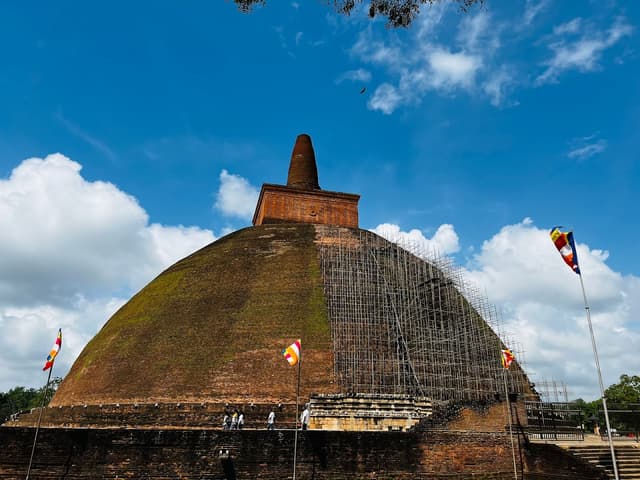
Abhayagiriya
@ravinkavish
Abhayagiriya, located in Anuradhapura, is one of the most significant monastic complexes of ancient Sri Lanka, renowned for its historical and archaeological value. Built by King Vattagamani Abhaya (also known as King Valagamba) in the 1st century BCE, it was once a thriving Buddhist center and a major hub for religious learning, with a vast library and thousands of monks residing there.
Abhayagiriya is known for its impressive ruins, including an enormous stupa, stone inscriptions, and remnants of monastic buildings, all set amidst a peaceful and expansive area. The stupa, though not as large as the Ruwanweli Maha Seya, is significant for its historical context and role in the island's Buddhist heritage.
Pro tip: When visiting Abhayagiriya, take time to explore the well-preserved ruins and imagine the bustling spiritual life that once took place here. The site provides a fascinating glimpse into the early days of Buddhism in Sri Lanka, and the serene atmosphere makes it an excellent place for reflection and exploration.
Add to
Details

Isurumuniya Temple
@ravinkavish
Isurumuniya Temple, located near the famous sacred city of Anuradhapura, is one of Sri Lanka's most captivating historical and cultural landmarks. Dating back to the 3rd century BCE, it was originally established by King Devanampiyatissa. The temple is known for its stunning rock carvings and unique architectural features, including a serene pond and intricately designed stone sculptures.
The temple’s most famous feature is the "Isurumuniya Lovers" sculpture, a well-known piece of ancient art depicting a couple in a loving embrace, which is widely considered a masterpiece of Sri Lankan rock art. Another notable attraction is the temple's beautiful frescoes and stone carvings of animals and religious symbols.
Pro tip: When visiting Isurumuniya Temple, make sure to explore the tranquil surroundings and take time to appreciate the ancient rock carvings. The peaceful environment and rich history make it an excellent spot for reflection and photography, especially for those interested in Sri Lanka's artistic and cultural heritage.
Add to
Details
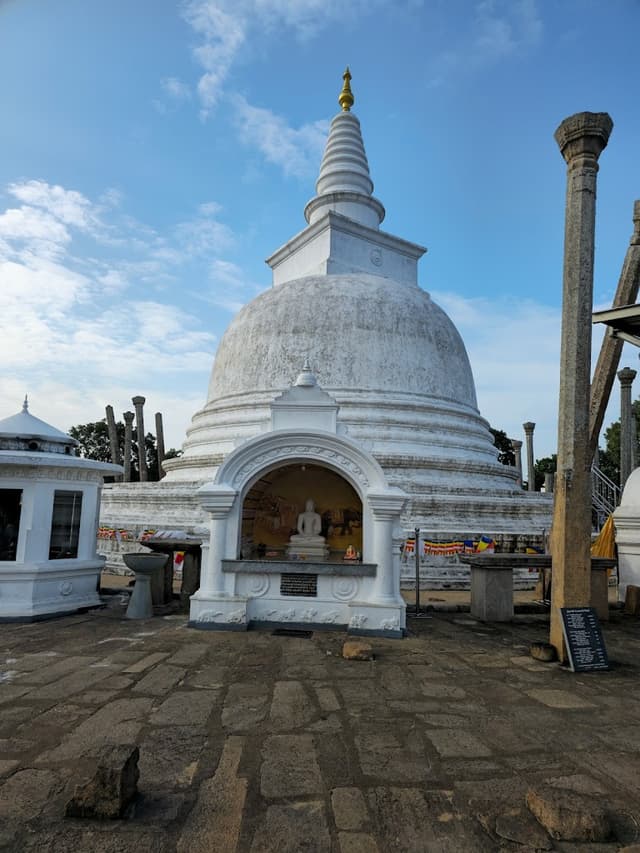
Thuparamaya
@ravinkavish
Thuparamaya, located in Anuradhapura, is one of Sri Lanka's oldest and most sacred Buddhist stupas. It was the first stupa built after the introduction of Buddhism to Sri Lanka by Emperor Ashoka’s missionary, Mahinda, in 247 BCE. Thuparamaya is said to house a relic of the Buddha, making it a significant pilgrimage site for Buddhists.
The stupa's simple yet striking design features a large white dome, which has been beautifully preserved over the centuries. Its historical and religious importance is further highlighted by the ancient stone pillars surrounding the site, which are remnants of the original structure built by King Devanampiyatissa.
Pro tip: While visiting Thuparamaya, take time to appreciate the tranquil surroundings and the rich history of this sacred site. It's a must-see for anyone interested in Sri Lanka’s Buddhist heritage and the early days of Buddhism on the island. The peaceful atmosphere makes it an ideal spot for reflection and exploration.
Add to
Details

Jethawanaramaya
@ravinkavish
Jetavanaramaya, located in Anuradhapura, is one of the largest and most impressive ancient stupas in Sri Lanka. Built by King Mahasena in the 3rd century CE, it was originally the tallest structure in the world, standing at 122 meters (400 feet). The stupa was constructed as a tribute to Lord Buddha and is one of the most important landmarks of Anuradhapura's historical city.
Jetavanaramaya is renowned for its size, both in terms of height and volume. The stupa is encircled by ancient ruins, including remnants of monastic buildings and meditation chambers. The site once housed relics of the Buddha and was a major center for Buddhist learning.
Pro tip: Visit Jetavanaramaya to marvel at the scale and grandeur of this ancient monument. While much of the stupa’s original splendor has faded, its enormous size and the surrounding ruins offer an awe-inspiring glimpse into the architectural achievements of ancient Sri Lanka. It’s a must-visit for history enthusiasts and those keen on exploring the cultural heritage of Sri Lanka’s ancient capitals.
Add to
Details
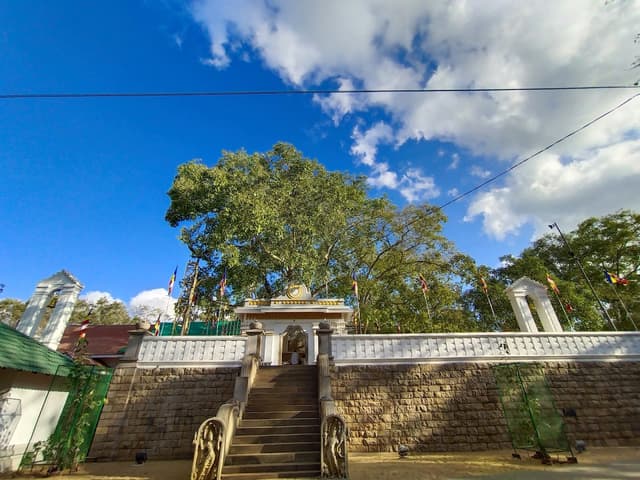
Jaya Sri Maha Bodhi
@ravinkavish
Jaya Sri Maha Bodhi, located in Anuradhapura, is one of the most sacred and revered sites in Sri Lanka and the world’s oldest historically documented tree. It is a direct descendant of the tree under which the Buddha attained enlightenment in Bodh Gaya, India. The tree was planted in 288 BCE by King Devanampiyatissa, making it over 2,300 years old.
This sacred Bodhi tree is situated in a beautifully serene environment within the Mahamewna Gardens and is surrounded by various shrines and monuments. Pilgrims from all over the world come to pay homage and meditate under its branches, as it is considered a symbol of peace, enlightenment, and spiritual strength.
Pro tip: When visiting Jaya Sri Maha Bodhi, take time to quietly reflect and experience the spiritual ambiance. The site is particularly beautiful during early mornings or evenings when the soft light and peaceful surroundings create a calm, meditative atmosphere. It’s a must-visit for anyone exploring Sri Lanka’s deep Buddhist heritage.
Add to
Details

Lovamahapaya
@ravinkavish
Lovamahapaya, also known as the "Brazen Palace," is an ancient structure located in Anuradhapura, Sri Lanka. Built by King Dutugemunu in the 2nd century BCE, this five-story building was originally intended as a residence for monks, and it was one of the most magnificent architectural feats of its time. The name "Brazen Palace" refers to the brass or bronze roof tiles that once covered the structure, giving it a golden, radiant appearance in the sunlight.
The building was made from timber and stone, and although only the foundations and some columns remain today, its size and design are still awe-inspiring. The palace originally housed over 1,000 monks and was a key center of learning and religious practice.
Pro tip: When visiting Lovamahapaya, take a moment to appreciate the size and scale of the ruins and imagine how grand it must have been in its prime. The site offers stunning views of the surrounding area, including the nearby Ruwanweli Maha Seya and other important historical landmarks. It's a must-see for anyone interested in Sri Lanka’s ancient architecture and Buddhist heritage.
Add to
Details

Dalada Maligawa Anuradhapura
@ravinkavish
Add to
Details

Lankaramaya | ලංකාරාමය
@ravinkavish
Add to
Details

Elephant Pond ඇත් පොකුණ
@ravinkavish
Add to
Details

Twin ponds (Kuttam Pokuna)
@ravinkavish
Kuttam Pokuna, also known as the Twin Ponds, is an exceptional ancient bathing complex located in Anuradhapura. These two beautifully crafted ponds, which date back to the 8th century, were part of the royal monastery and are considered a marvel of ancient engineering. The ponds are meticulously designed with fine stone carvings and steps leading to the water, showcasing the advanced hydraulic knowledge of the time.
The larger pond is rectangular, while the smaller one is round, and both are fed by a sophisticated system of channels and reservoirs. The Twin Ponds were used for ceremonial bathing by the monks and royal figures, and their well-preserved state offers insight into the artistic and architectural achievements of ancient Sri Lanka.
Pro tip: When visiting Kuttam Pokuna, take time to admire the intricate stonework and the serene atmosphere around the ponds. It's a peaceful spot for photography, offering a unique view of ancient Sri Lankan design and a quiet retreat from the busy city. The ponds are particularly beautiful during the early morning or late afternoon light.
Add to
Details

Mirisawetiya Temple
@ravinkavish
Mirisawetiya Temple, located in Anuradhapura, is one of the most significant and sacred Buddhist sites in Sri Lanka. It was built by King Dutugemunu in the 2nd century BCE, following his victory over the South Indian Chola invaders, to enshrine a relic of the Buddha’s tooth. The name "Mirisawetiya" translates to "Chili Stupa," which is believed to refer to the offerings of chili (miris) made to the stupa during its consecration.
The stupa is a remarkable example of ancient Sri Lankan Buddhist architecture, with its pristine white dome standing tall among the ruins of the ancient city. Over the centuries, the stupa and surrounding temple complex have been restored, and it remains an important place of worship for both locals and pilgrims.
Pro tip: When visiting Mirisawetiya Temple, take time to admire the peaceful surroundings and the striking architecture of the stupa. The site offers a sense of serenity and reflection, making it an ideal spot to learn more about Sri Lanka’s deep-rooted Buddhist history. The area is less crowded compared to other major sites in Anuradhapura, providing a more tranquil experience for visitors.
Add to
Details

Star Gate - Ranmasu Uyana
@ravinkavish
The Star Gate, located in Ranmasu Uyana, is one of Sri Lanka's most fascinating and mysterious ancient sites. Ranmasu Uyana, also known as the "Royal Pleasure Gardens," is an archaeological park in Anuradhapura, which was once a royal garden used by the kings of ancient Sri Lanka. The Star Gate is an intriguing structure, believed by some to be an astronomical observatory or a ceremonial gateway.
The Star Gate is a large stone arch with carvings that some researchers suggest may have been aligned with celestial events, such as the movement of stars or the solstices. Its exact purpose remains a mystery, but it is widely believed to have been a significant site for ancient Sri Lankan astronomy or religious rituals.
Pro tip: When visiting the Star Gate, take time to appreciate the intricate stone carvings and the peaceful garden setting. It’s an excellent spot for history enthusiasts and those interested in the mysteries of ancient Sri Lanka. The site offers a glimpse into the sophisticated knowledge and cultural practices of the ancient kingdom.
Add to
Details

Vessagiriya | වෙස්සගිරිය - අනුරාධපුරය
@ravinkavish
Add to
Details

Long Service Bus Stand - Anuradhapura
@ravinkavish
Add to
Details
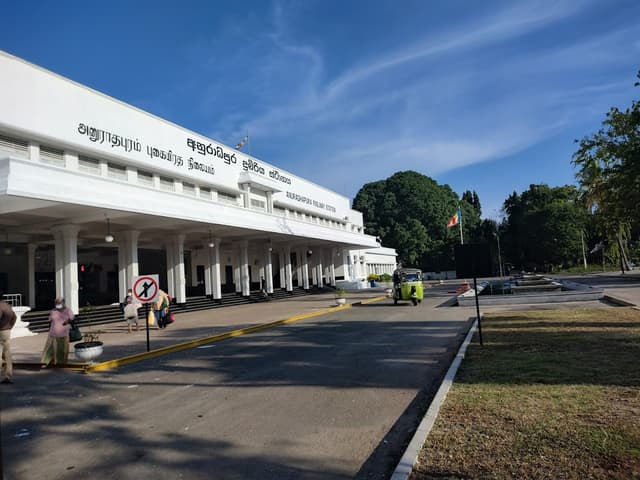
Railway Station - Anuradhapura
@ravinkavish
Add to
Details

Dhaiyagama Junction Bus Stop to Kebithigollewa bus Stop
@ravinkavish
Add to
Details

Kebithigollewa Bus Stop to Trincomalee
@ravinkavish
Add to
Details

6. Trincomalee
@ravinkavish
Add to
Details

Velgam Vehera Buddhist Temple
@ravinkavish
Add to
Details

Sri Lakshmi Narayana Perumal Kovil
@ravinkavish
Add to
Details

Fort Frederick
@ravinkavish
Add to
Details
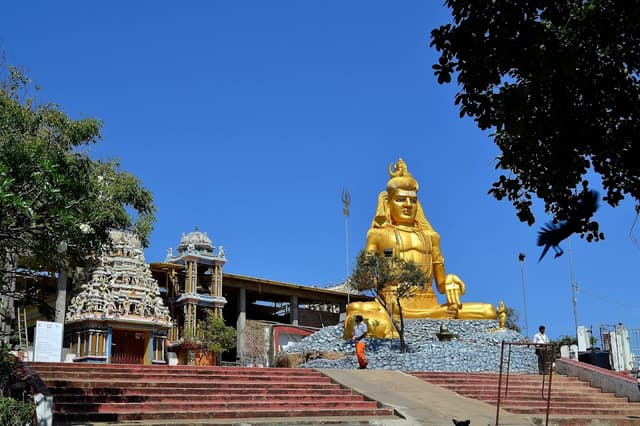
Thirukoneswaram Kovil
@ravinkavish
Add to
Details

Lovers Leap View Point Trincomalee
@ravinkavish
Add to
Details

Sampur Lighthouse | Foul Point Lighthouse
@ravinkavish
Add to
Details

Kottiyarama Mula Maha Viharaya - ඓතිහාසික කොට්ටියාරම මූල මහා විහාරය
@ravinkavish
Add to
Details

Wilgamwehera Rajamaha Viharaya (Mahamevnawa Buddhist Monastery)
@ravinkavish
Add to
Details

Naval Museum
@ravinkavish
Add to
Details

Samudragiri Jungle Monastery (Samudragiri Wana Senasuna)
@ravinkavish
Add to
Details

Dolphin Watching Site
@ravinkavish
Add to
Details

Nilaveli Beach
@ravinkavish
Add to
Details

Pigeon Island Marine National Park
@ravinkavish
Add to
Details
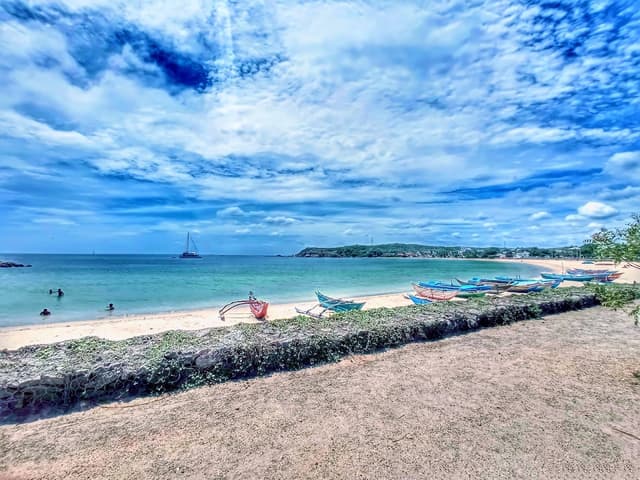
Dutch Bay Beach
@ravinkavish
Add to
Details

Trincomalee Town Beach
@ravinkavish
Add to
Details

Villuntri Kandaswamy Temple
@ravinkavish
Add to
Details
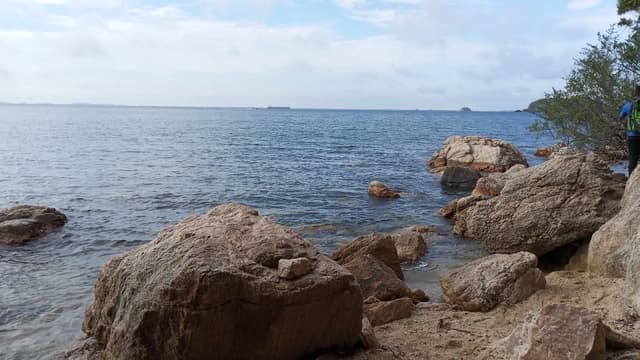
Stone cave
@ravinkavish
Add to
Details

Marble Beach
@ravinkavish
Add to
Details
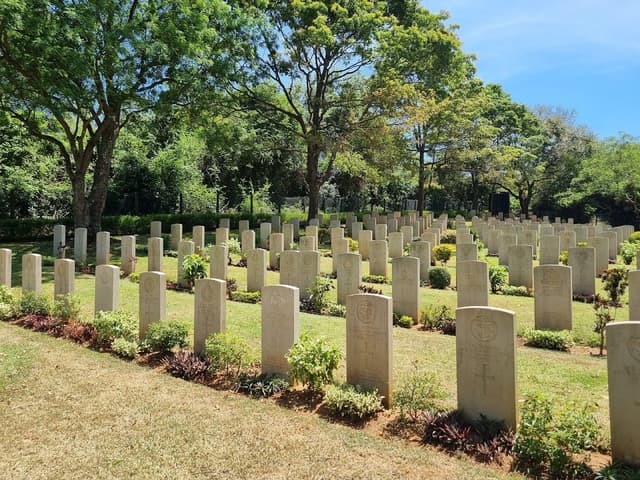
Trincomalee War Cemetery
@ravinkavish
Add to
Details

Girihandu Seya
@ravinkavish
Add to
Details

Arisimale Beach
@ravinkavish
Add to
Details

Central Bus Station - Trincomalee
@ravinkavish
Add to
Details

Jaffna
@ravinkavish
Add to
Details

Kovalam light house | கோவளம் வெளிச்ச வீடு
@ravinkavish
Add to
Details

Kankesanthurai Lighthouse
@ravinkavish
Add to
Details
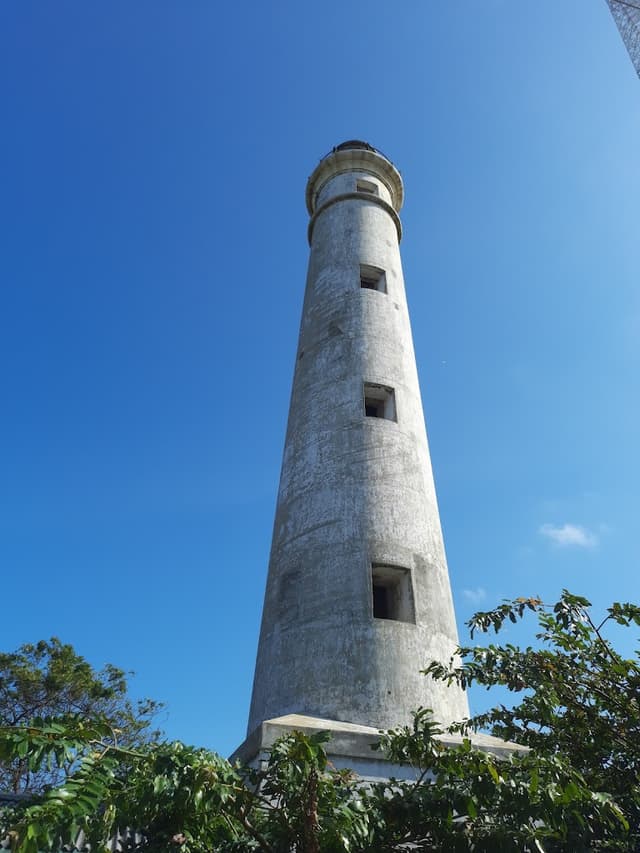
Point Pedro Lighthouse
@ravinkavish
Add to
Details

Dutch Fort - Jaffna
@ravinkavish
Add to
Details

Jaffna Archeological Museum
@ravinkavish
Add to
Details

Nallur Kandaswamy Devasthanam
@ravinkavish
Add to
Details

Jaffna Public Library
@ravinkavish
Add to
Details

Fort Hammenhiel
@ravinkavish
Add to
Details

Queen's Tower - Delft Island
@ravinkavish
Add to
Details

Vediyarasan Fort
@ravinkavish
Add to
Details

Horse Sightings
@ravinkavish
Add to
Details

Delft National Park
@ravinkavish
Add to
Details

Dutch Fort - Delft Island
@ravinkavish
Add to
Details

Kal Munai Old Survey Tower
@ravinkavish
Add to
Details

Keerimalai Naguleswaram temple
@ravinkavish
Add to
Details
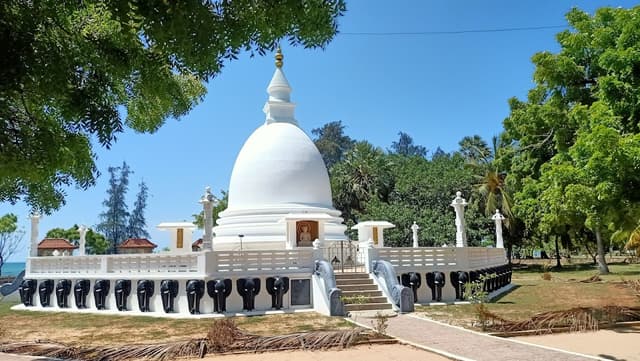
Dambakolapatuna Sangamiththa Temple
@ravinkavish
Add to
Details

Casuarina Beach
@ravinkavish
Add to
Details

Inuvil Kanthaswamy Kovil
@ravinkavish
Add to
Details

Jaffna Divisional Secretariat Bus Stop
@ravinkavish
Add to
Details

Jaffna Railway Station
@ravinkavish
Add to
Details

Colombo Bandaranaike International Airport
@ravinkavish
Add to
Details

Colombo
@ravinkavish
Colombo, Sri Lanka’s vibrant capital, is a dynamic blend of modernity and history, offering travelers a unique mix of culture, cuisine, and charm. This bustling metropolis is home to a diverse array of attractions, from ancient temples and colonial-era buildings to contemporary skyscrapers and chic cafes.
Explore the historic Fort area, where Dutch and British colonial architecture meet modern developments, or stroll along Galle Face Green, a seaside promenade perfect for catching sunsets. For those interested in culture, the Gangaramaya Temple and Independence Square showcase the city's rich heritage. Colombo also boasts lively markets like Pettah, where you can shop for everything from spices to souvenirs.
Pro tip: Colombo is a great starting or ending point for your Sri Lankan journey, with convenient access to the airport. Plan to spend at least a day exploring its highlights and indulging in the local cuisine, especially at the trendy restaurants and street food stalls scattered across the city.
Add to
Details

One Galle Face Mall
@ravinkavish
One Galleface is an ultra-modern mixed-use development located in the heart of Colombo, offering a blend of luxury, commerce, and entertainment. As Sri Lanka's first integrated lifestyle and business complex, it features a stunning 45-story tower that houses high-end offices, residential apartments, a luxury hotel, and a shopping mall. The development is a significant part of Colombo’s skyline, with its sleek design and prime location by the sea.
Visitors to One Galleface can enjoy a wide range of dining, shopping, and entertainment options, with a contemporary mall that houses both international and local brands. The rooftop offers breathtaking views of the Indian Ocean and Colombo’s cityscape, making it a great spot for relaxing or dining with a view.
Pro tip: Visit in the evening to enjoy the vibrant atmosphere, take in the city lights, and experience Colombo's modern side. One Galleface is ideal for travelers looking for a mix of luxury shopping, fine dining, and stunning city views.
Add to
Details

Presidential Secretariat
@ravinkavish
The **Presidential Secretariat** in Colombo is a grand colonial-era building that serves as the official office of the President of Sri Lanka. Built in **1930**, this iconic structure was originally the General Post Office during British rule. Its neoclassical architecture, characterized by towering columns and intricate details, reflects the grandeur of its historical origins.
Located near the bustling Galle Face Green, the Secretariat holds a significant place in Sri Lanka’s political history and governance. Although access to the building's interior is restricted, its striking façade and the surrounding area make it a popular spot for photography and sightseeing.
**Pro tip:** Combine your visit with a walk along Galle Face Green to enjoy the area’s historical and modern landmarks. The illuminated view of the Secretariat at night adds a touch of elegance to Colombo’s cityscape.
Add to
Details

Colombo Galbokka Lighthouse
@ravinkavish
Add to
Details

Colombo Fort Old Lighthouse & Clock Tower
@ravinkavish
The **Old Colombo Lighthouse and Clock Tower**, located in the Colombo Fort area, is an iconic historical landmark with a fascinating dual purpose. Built in **1857** during British rule, this 29-meter-tall structure initially served as a lighthouse guiding ships into Colombo's harbor. In **1914**, its light was deactivated as taller buildings obscured its beam, but it continues to function as a clock tower.
Designed by Lady Ward, the wife of Governor Sir Henry Ward, the tower’s neo-classical architecture adds charm to Colombo's bustling financial district. The clock mechanism, made in England, is still operational, making it one of Asia’s oldest clock towers in continuous use.
**Pro tip:** Look out for the engraved royal insignia near the base, and combine your visit with a walk around the Colombo Fort area to discover more colonial-era gems.
Add to
Details

Dutch Hospital - Shopping Precinct
@ravinkavish
The **Dutch Hospital Shopping Precinct**, located in the heart of Colombo, is a beautifully restored colonial building that dates back to the **17th century**. Originally a hospital during Dutch rule, it is considered one of the oldest surviving structures in Colombo. Its thick walls and terracotta roof tiles reflect classic Dutch colonial architecture, seamlessly blending history with modernity.
Today, the precinct is a vibrant hub of activity, housing high-end boutiques, restaurants, and cafes. It’s the perfect spot to shop for souvenirs, indulge in fine dining, or simply relax with a drink in its open-air courtyards. The atmosphere comes alive in the evenings with live music and a lively crowd.
**Pro tip:** Try the local seafood at one of the restaurants, and don’t miss exploring the nearby landmarks like the World Trade Center and Old Colombo Lighthouse. It’s an ideal mix of history, culture, and modern-day leisure.
Add to
Details

Jami Ul-Alfar Mosque
@ravinkavish
The **Jami Ul-Alfar Mosque**, also known as the **Red Mosque**, is one of Colombo’s most striking landmarks. Located in the heart of the city, near the bustling Pettah market area, this mosque was built in **1909** and is renowned for its unique and vibrant red-and-white striped exterior, which makes it instantly recognizable. Its Indo-Saracenic architectural style blends Islamic design with local influences, making it one of the most beautiful mosques in Sri Lanka.
The mosque is an active place of worship and has become a symbol of the multicultural nature of Colombo. While the mosque itself is not open to non-Muslim visitors during prayer times, its impressive architecture makes it a popular spot for photographs.
**Pro tip:** Visit the mosque during the early morning or late afternoon to capture its beauty in the soft natural light. While you're in the area, explore the nearby Pettah market for a true taste of Colombo’s vibrant street life.
Add to
Details

Colombo Lotus Tower
@ravinkavish
Add to
Details

Colombo Town Hall
@ravinkavish
The Colombo Town Hall, built in **1928**, is one of the most iconic colonial-era landmarks in the city. Designed in a Neo-Classical style, the building features a grand white façade with towering pillars and a central dome reminiscent of Washington, D.C.’s Capitol building. It was originally constructed to house the administrative offices of the Colombo Municipal Council and still serves that purpose today.
Set amidst the lush greenery of **Viharamahadevi Park**, the Town Hall is a favorite spot for photography and sightseeing. Though the building itself is not open for tours, its majestic exterior and surroundings make it a must-see while exploring Colombo.
**Pro tip:** Visit during the evening when the building is beautifully illuminated. Pair it with a walk through Viharamahadevi Park for a relaxing escape from the city’s hustle and bustle.
Add to
Details

Viharamahadevi Park
@ravinkavish
Viharamahadevi Park, Colombo’s largest and oldest public park, is a lush green haven amidst the city’s bustling streets. Originally named **Victoria Park** during the British colonial era, it was later renamed in honor of **Queen Viharamahadevi**, a revered figure in Sri Lankan history. The park boasts a rich history, dating back to the late **19th century**, and has been a cherished spot for locals and visitors alike.
The park is adorned with vibrant flower beds, tall palm trees, and tranquil water features, making it a perfect spot for relaxation and picnics. It also features a children’s play area, a mini zoo, and a golden statue of Buddha, adding to its charm. The park often hosts cultural events, making it a lively hub of activity.
**Pro tip:** Visit early in the morning or late afternoon to enjoy the park’s cool breeze. It’s a wonderful place to unwind after exploring Colombo’s landmarks, with attractions like the Colombo Town Hall and National Museum just a short walk away.
Add to
Details

Gangaramaya Temple
@ravinkavish
The Gangaramaya Temple, located near Beira Lake in Colombo, is one of Sri Lanka’s most significant and vibrant Buddhist temples. Established in the late **19th century** by scholar-monk **Hikkaduwe Sri Sumangala Thero**, this temple is not just a place of worship but also a cultural and architectural gem blending traditional, Thai, Indian, and Chinese styles.
The temple complex houses a richly adorned main shrine, a museum showcasing ancient artifacts and gifts from around the world, and a library. Visitors are drawn to its serene ambiance, intricate statues of Buddha, and the sacred Bodhi tree. The temple is also the centerpiece of the annual Navam Perahera, a grand procession celebrated with elephants, dancers, and traditional music.
**Pro tip:** Dress modestly and explore both the temple and nearby Seema Malaka, a floating meditation hall on Beira Lake. It's a peaceful and spiritual escape in the heart of bustling Colombo.
Add to
Details

Colombo National Museum
@ravinkavish
The Colombo National Museum is a treasure trove of the island's rich history and cultural heritage. Established in **1877** by Sir William Henry Gregory, then British Governor of Ceylon, the museum is housed in a grand colonial building set amidst a lush, serene garden.
Inside, you’ll find an extensive collection of artifacts ranging from ancient Buddhist sculptures, royal regalia of Sri Lankan kings, traditional masks, and ancient manuscripts. Highlights include the **golden throne of King Wimaladharmasuriya II** and a stunning collection of Kandyan-era crafts. The museum offers an immersive journey into Sri Lanka’s past, spanning over 2,500 years.
**Pro tip:** Allocate at least a couple of hours to explore the galleries. Photography is permitted, but flash is prohibited. After your visit, relax in the museum’s beautiful garden or enjoy nearby cafés. A must-visit for history buffs and culture enthusiasts!
Add to
Details

Independence Square
@ravinkavish
Independence Square in Colombo is a historically significant landmark that commemorates Sri Lanka's independence from British rule on February 4, 1948. At its heart lies the Independence Memorial Hall, a grand open pavilion inspired by traditional Kandyan architecture, symbolizing the country’s rich heritage and freedom. The hall is flanked by stone lions and surrounded by lush greenery, offering a peaceful escape within the bustling city.
The site also houses the Independence Memorial Museum, which showcases artifacts and stories from Sri Lanka’s journey to independence. It’s a favorite spot for locals and travelers alike, whether for a leisurely stroll, a jog, or simply soaking in the historical ambiance.
**Pro tip:** Visit in the early morning or evening for cooler weather and vibrant cultural events that sometimes take place here. Independence Square offers a unique mix of history, architecture, and modern-day tranquility.
Add to
Details

Arcade Independence Square
@ravinkavish
Arcade Independence Square is a popular shopping complex in Colombo. However, this was a renovated building which was a Lunatic Asylum in the beginning when it was constructed in 1889 during the British era 🇬🇧. Later, this was occupied by many government institutions until it was refurbished and opened as an upmarket shopping mall in 2012 due to its prime location. The complex features a variety of shops, from high-end boutiques to local craft stores, and offers numerous dining options, including restaurants and cafes. Located near the Independence Memorial Hall, Arcade Independence Square is known for its serene gardens, water fountains, and open courtyards. It often hosts cultural events and live performances, making it a lively spot for both locals and tourists. With its blend of historical charm and modern amenities, it’s a must-visit destination in Colombo.
Add to
Details

Galle Face Green
@ravinkavish
Galle Face Green is a lively urban park stretching along Colombo’s coastline, offering breathtaking views of the Indian Ocean. Originally laid out in **1859** by Sir Henry Ward, the British Governor of Ceylon, this iconic promenade was once used for horse racing and recreational activities. Today, it’s a favorite gathering spot for locals and travelers alike, renowned for its stunning sunsets and relaxed atmosphere.
The open space is perfect for a leisurely stroll, flying kites, or enjoying street food from vendors selling local favorites like **isso wade** (prawn fritters). Nearby landmarks include the historic Galle Face Hotel and the striking Colombo Lotus Tower, making it a great starting point for exploring the city.
**Pro tip:** Visit in the late afternoon to enjoy the cool sea breeze, try some local snacks, and witness the bustling energy of Colombo’s residents unwinding by the sea.
Add to
Details

Maradana Railway Station
@ravinkavish
Add to
Details

Fort Railway station
@ravinkavish
Add to
Details

Kandy Intercity Bus Station
@ravinkavish
Add to
Details

Kandy
@ravinkavish
Kandy, nestled in the lush hill country of Sri Lanka, is a city of deep cultural, historical, and spiritual significance. As the last capital of the ancient Sinhala kings, it played a crucial role in preserving the island’s heritage during colonial times. The city’s crown jewel is the Temple of the Sacred Tooth Relic (Sri Dalada Maligawa), which houses a sacred tooth of the Buddha and is a UNESCO World Heritage Site.
Surrounded by emerald-green hills, Kandy is also known for the picturesque Kandy Lake, which adds to its serene atmosphere. The city comes alive during the annual Esala Perahera, a grand cultural procession featuring elephants, dancers, and drummers that pay homage to the Sacred Tooth Relic.
Beyond its cultural attractions, Kandy offers a gateway to nature, while the Royal Botanical Gardens in Peradeniya showcases a stunning collection of flora. The bustling streets of Kandy are perfect for sampling local delights like Kandyan sweets or shopping for traditional crafts and jewelry.
**Pro tip:** Visit the city in the early morning to explore the Temple of the Tooth before the crowds, and plan a sunset walk around the lake for spectacular views of Kandy’s skyline. Don’t miss the chance to take a scenic train ride to or from Kandy, one of the most beautiful rail journeys in the world.
Add to
Details

Bahirawakanda Temple
@ravinkavish
Add to
Details

Kataragama Devalaya
@ravinkavish
Add to
Details

St Paul's Church, Kandy
@ravinkavish
St. Paul’s Church in Kandy is a historical Anglican church that stands as a quiet testament to the colonial era and the city’s multicultural heritage. Located adjacent to the Temple of the Sacred Tooth Relic, this charming church offers a fascinating contrast to the Buddhist temples of Kandy while sharing in the spiritual tranquility of the area.
Built between 1843 and 1852, during the British colonial period, St. Paul’s Church served as a place of worship for British officers and residents. Its neo-Gothic architecture, featuring stained glass windows, intricate wooden pews, and a stately bell tower, reflects classic British ecclesiastical designs of the 19th century. The interior is serene and simple, with polished wooden beams and a peaceful ambiance ideal for reflection.
The church is still active today, hosting services and welcoming visitors of all faiths. Its proximity to the Temple of the Sacred Tooth Relic makes it a unique stop for travelers exploring the rich spiritual and cultural tapestry of Kandy.
**Pro tip:** After visiting the church, enjoy a leisurely walk around Kandy Lake, located just across the road, to soak in the serene beauty of the hill capital. Don’t forget to check the service schedule if you’d like to attend a traditional Anglican worship session.
Add to
Details

Ehelepola Walawwa
@ravinkavish
This under-rated site now been used as an administrative office by the Archaeology Department in Rathnapura. This is the "Consorts" Castle of Ehelepola Nilame (1773 – 1829) was a courtier of the Kingdom of Kandy. He was the first Adigar (a role which combined the powers of a prime minister and a chief justice) from 1811 to 1814 under the reign King Sri Vikrama Rajasinha (Last King of the country). He was appointed by the king as the Disawe (local governor) of Sabaragamuva. His Mansion (Walawwa) is separate from this Mansion which is currently the house to Rathnapura Museum. Apart from this he has a separate mansion built in Kandy as well. Not even the King had a structure of this magnitude for his consorts during the Kandyan era. Wooden teak floors and the Architecture resembles the meticulously given details when building the mansion which was housed to the British agents since 1917 after the fall of the Kandyan Kingdom and its ruling provinces to the British Empire.
Add to
Details

Sri Dalada Maligawa
@ravinkavish
The Sri Dalada Maligawa, or Temple of the Sacred Tooth Relic, is one of the most revered Buddhist sites in the world, located in the heart of **Kandy**. This temple is home to the Tooth Relic of Lord Buddha, an artifact that holds immense spiritual and historical significance to Buddhists in Sri Lanka and around the world. The relic is believed to have been brought to Sri Lanka in the 4th century and has played a key role in the island’s religious and political history.
The temple itself is a stunning example of Kandyan architecture, with intricate wooden carvings, golden embellishments, and beautifully decorated interiors. The Inner Chamber, where the Tooth Relic is kept, is carefully guarded and is only opened during religious ceremonies. Devotees from across the world come to offer their prayers, and special rituals, such as the Dalada Perahera (a grand procession), are held annually in July and August to honor the relic.
The Sri Dalada Maligawa is located near Kandy Lake, which adds to the tranquil and sacred atmosphere of the temple. Visitors can explore the various halls, courtyards, and shrines within the complex, each with its own cultural and historical importance.
**Pro tip:** When visiting, ensure you dress modestly as the temple is a sacred site. Also, consider visiting during the evening for the special puja (prayer) ceremony to witness the religious rituals surrounding the sacred relic.
Add to
Details

Queen's Palace - Madawasala
@ravinkavish
“Medavasala” which is the Queen’s Chamber. Residence of Queen Venkatha Ranga Jammal (Rengammal) the last Queen of the King Sri Wickrama Rajasinghe (1798-1815 AD) who is also the last King of the Kandyan Kingdom before it fell to the hands of the British empire in 1815. The entrance door to the Queen’s chamber exemplifies the exquisite features of the Kandyan period architecture and when the door is closed it can only be opened from the inside as a measure of security. The remains of a Urinal Stone can be seen as well in the chamber right along side her bed. All made of stone and wooden. Wooden pillars consists of rectangular and octangular sections with wood carvings.
Add to
Details

Kandy City Centre
@ravinkavish
Add to
Details

Kandy view point
@ravinkavish
Add to
Details

Kandy Lake Club - Cultural Dance Show
@ravinkavish
Add to
Details

Royal Botanic Gardens, Peradeniya
@ravinkavish
The Royal Botanic Gardens, Peradeniya, located just outside the bustling city of Kandy, is one of Sri Lanka's most renowned gardens and a must-visit for nature lovers and travelers. Spanning over 147 acres, this beautifully landscaped garden is home to more than 4,000 species of plants, including tropical and subtropical trees, palms, orchids, and medicinal plants. It offers a peaceful retreat, allowing visitors to immerse themselves in lush greenery while exploring its various themed sections.
The Royal Botanic Gardens have a rich history, dating back to the early 14th century when it was initially established as a royal garden by King Kirthi Sri Rajasinha in the 18th century. However, it was during the British colonial period that the gardens were expanded and modernized, making it one of the finest botanic gardens in Asia.
Among the most notable attractions within the garden is the Avenue of Royal Palms, which creates an impressive entryway, and the Orchid House, which showcases a stunning collection of orchids. There's also the Gingko Biloba Tree, believed to be over 2,000 years old, and the Cannonball Tree, known for its large, round fruits. The garden is also home to a variety of bird species, making it a fantastic spot for birdwatching.
One of the highlights is the Coconut Palm Collection, which is recognized as one of the most diverse in the world, and the Spice Garden, where visitors can learn about Sri Lanka's famous spices like cinnamon, cardamom, and pepper.
For those looking to enjoy a more leisurely experience, there are plenty of shaded paths, large grassy lawns perfect for picnics, and even boat rides on the nearby river.
**Pro tip:** The gardens are a great spot to take a relaxing walk or enjoy a peaceful afternoon picnic. If you're a nature or photography enthusiast, don’t forget your camera to capture the stunning flora and wildlife.
Add to
Details

Gadaladeniya Raja maha viharaya
@ravinkavish
Gadaladeniya Raja Maha Viharaya is a historic Buddhist temple located near Peradeniya in the Kandy District of Sri Lanka. Built in the 14th century, it is renowned for its unique architectural style that combines both Sinhalese and South Indian influences, reflecting the cultural exchanges between Sri Lanka and South India during that era.
The temple was constructed during the reign of King Bhuvanekabahu IV, and it is said to have been designed by a South Indian architect, Godaya, whose influence can be seen in the temple's intricate design. The structure is primarily made of stone and wood, with beautiful carvings and sculptures that showcase the skill of ancient artisans. One of the most notable features is the Vahalkada (porch), with its finely crafted stone pillars and beautiful arches.
The main attraction of the temple is the image house, where a serene statue of Buddha is housed, surrounded by vibrant frescoes depicting the life of the Buddha and other religious themes. The temple also has a stupa (sacred mound), which serves as a focal point for meditation and prayer.
Despite its relatively small size compared to other historical sites in Sri Lanka, Gadaladeniya Raja Maha Viharaya offers a peaceful and serene atmosphere, making it an ideal spot for reflection and exploration of Sri Lanka's rich Buddhist heritage.
**Pro tip:** Visitors to the temple can enjoy the surrounding natural beauty and take a short hike to Lankatilaka Viharaya, another significant temple located nearby, for a full experience of this religious and cultural area.
Add to
Details

Sri Lankathilake Rajamaha Viharaya
@ravinkavish
Sri Lankathilake Rajamaha Viharaya, located in the historic town of Kandy, is an ancient Buddhist temple rich in history and architectural beauty. This serene temple is known for its impressive structure, which features intricate carvings, a large Buddha statue, and a stunning view of the surrounding hills and countryside. Its peaceful ambiance makes it a great spot for those interested in Sri Lanka’s religious heritage and architectural marvels.
Dating back to the 14th century, Sri Lankathilake Rajamaha Viharaya was built by King Parakramabahu VI and is one of the most significant temples in the region. It is also a great place to learn about Sri Lanka’s rich cultural and spiritual traditions.
**Pro tip:** While visiting the temple, take time to explore the surrounding area, which offers picturesque views and a tranquil atmosphere perfect for reflection and relaxation. The temple is best enjoyed during early morning or late afternoon when the weather is cooler, and the crowds are fewer.
Add to
Details

Embekka Dewalaya
@ravinkavish
Embekka Devalaya, located in the quaint village of Embekka near Kandy, is a masterpiece of ancient Sri Lankan woodcraft and cultural heritage. Built during the Gampola Kingdom in the 14th century by King Wickramabahu III, this shrine is dedicated to Kataragama Deviyo, a guardian deity in Sri Lankan tradition.
What makes Embekka truly remarkable is its intricately carved wooden pillars and beams. The carvings depict a variety of fascinating motifs, from floral designs to mythological figures, showcasing the exceptional skill of medieval Sri Lankan artisans. The Hall of Drummers (Digge), with its captivating wooden artistry, is particularly famous and draws admiration from art enthusiasts and travelers alike.
**Pro tip:** Visit during the morning to enjoy the serene atmosphere and the finer details of the woodwork in natural light. Pair your trip with visits to nearby cultural landmarks like Lankatilaka and Gadaladeniya temples for a deeper dive into Sri Lanka's rich history and art.
Add to
Details

Ambuluwawa Tower
@ravinkavish
The Ambuluwawa Tower, perched atop the Ambuluwawa Mountain near Gampola, is one of Sri Lanka's most breathtaking landmarks. This striking tower is part of the Ambuluwawa Biodiversity Complex, inaugurated in 2009 to promote environmental harmony and religious coexistence. The spiral design of the tower is inspired by a Buddhist stupa and symbolizes unity among the island’s diverse cultures and beliefs.
Climbing the tower is an exhilarating experience as the winding staircase narrows at higher altitudes, offering a thrilling ascent. Once at the top, you're rewarded with panoramic views of rolling hills, lush valleys, and distant peaks, including the Knuckles Mountain Range. The complex also features religious shrines representing Buddhism, Hinduism, Islam, and Christianity, emphasizing the area’s inclusive spirit.
**Pro tip:** Arrive early to beat the crowds and enjoy the sunrise, which paints the surrounding landscapes in stunning hues. The ascent can be challenging, so wear comfortable shoes and prepare for strong winds at the peak!
Add to
Details

Malwatu Chapter Monastery
@ravinkavish
Add to
Details

Hanthana Mount Start Campus Road
@ravinkavish
Add to
Details

Hanthana Mountain View Point
@ravinkavish
Add to
Details

Katusu Konda trek start
@ravinkavish
Add to
Details

Katusu Konda
@ravinkavish
Add to
Details

Kandy Railway Station
@ravinkavish
Add to
Details

Kandy-Colombo Intercity Bus Station
@ravinkavish
Add to
Details

Kandy Bus Stand
@ravinkavish
Add to
Details

Peradeniya Bus Stand
@ravinkavish
Add to
Details

Kandyan Cultural Centre
@ravinkavish
Highly Recommended for Culture Lovers
Cultural Performances Starts - 5:30 PM
Entrance Fee - 2500
One of the main attractions here is the traditional Kandyan dance performances. These shows are a high-energy mix of drumming, dancing, and acrobatics, featuring intricate costumes and colorful masks. It’s a fantastic way to experience Sri Lankan performing arts up close and feel the rhythm and energy of local traditions.
The center also offers a glimpse into traditional crafts. You can check out local artisans demonstrating their skills in areas like weaving, wood carving, and mask-making. It’s a cool chance to see how these ancient crafts are still practiced today.
The museum section of the center has displays of traditional Sri Lankan artifacts, including costumes, musical instruments, and ceremonial objects. It’s a great spot to learn about the cultural significance of these items and how they were used in ceremonies and daily life.
Overall, the Kandyan Cultural Centre is a vibrant hub for anyone looking to experience and understand the rich cultural heritage of Kandy. It’s lively, educational, and a lot of fun—perfect for getting a deeper dive into Sri Lankan culture.
Add to
Details

Nuwara Eliya
@ravinkavish
Nuwara Eliya, often referred to as "Little England," is a charming hill station nestled in the heart of Sri Lanka’s central highlands. Known for its cool climate, colonial-era architecture, and sprawling tea plantations, this picturesque town offers a unique blend of history, natural beauty, and leisure.
The town was established during the British colonial period and became a favorite retreat for the British elite. Today, you can still see colonial-style bungalows, red-brick post offices, and well-maintained gardens. Nuwara Eliya is also famous for its tea culture, and visiting a tea factory to witness the production process is a must. The serene Gregory Lake, lush Hakgala Botanical Garden, and the iconic Horton Plains National Park with the dramatic World's End viewpoint are among the many attractions in the area.
**Pro tip:** Nuwara Eliya is especially magical in April during the flower season and its vibrant horse races. Pack warm clothing as temperatures can drop, especially in the evenings. Don’t miss the chance to indulge in fresh strawberries and a steaming cup of locally grown Ceylon tea while soaking in the breathtaking views.
Add to
Details

Swarnagiri Maha Viharaya / Single Tree Temple
@ravinkavish
Swarnagiri Maha Viharaya, also known as the Single Tree Temple, is a peaceful and historically significant Buddhist temple located near Nuwara Eliya. This serene site is believed to have been established centuries ago and is named after the single ancient tree that stands in the temple's courtyard. The tree, thought to be a sacred Bo tree, adds to the spiritual ambiance of the temple, making it a place of meditation and reverence for locals and visitors alike.
The temple itself is modest yet beautiful, with traditional Buddhist architecture and a calm atmosphere. The surrounding area is lush with greenery, and the tranquil environment makes it a perfect spot for reflection. The temple is not as crowded as other tourist spots, offering visitors a peaceful retreat in the midst of Sri Lanka’s hill country.
**Pro tip:** Make sure to take some time to meditate or simply enjoy the quiet surroundings. It’s a great place for a peaceful escape while traveling through Nuwara Eliya.
Add to
Details

Post Office - Nuwara Eliya
@ravinkavish
The Nuwara Eliya Post Office is an iconic landmark in the heart of this charming hill town. Established in 1894 during the British colonial era, this Tudor-style red-brick building stands as a testament to Sri Lanka’s colonial heritage. Its steep roofs, wooden balconies, and vintage charm make it one of the most photographed spots in Nuwara Eliya.
Still functioning as a post office, the building offers a unique opportunity to send postcards to loved ones with a touch of history. It also houses a philatelic bureau, making it a must-visit for stamp collectors and history buffs. The picturesque setting adds to the allure, with the lush gardens and cool mountain air enhancing its timeless appeal.
**Pro tip:** Visit early in the morning to capture the post office in the soft light of the day, and don’t forget to explore other colonial-era gems in Nuwara Eliya like the Grand Hotel and Victoria Park!
Add to
Details

Victoria Park - Nuwaraeliya
@ravinkavish
Victoria Park in Nuwara Eliya is a beautifully landscaped oasis in the heart of the hill town, offering a perfect escape into nature. Established in 1897 to mark Queen Victoria's Diamond Jubilee, the park spans 27 acres and is home to vibrant flowerbeds, lush lawns, and towering trees. It's a favorite spot for both locals and travelers to relax and enjoy the cool mountain air.
The park is also a birdwatcher’s paradise, hosting species like the Indian Pitta and Pied Thrush. For families, there’s a children’s play area and a small train ride. During the blooming seasons, particularly from March to May and August to September, the park bursts into a riot of colors, making it one of the most photogenic spots in Nuwara Eliya.
**Pro tip:** Visit in the morning for the best light and fewer crowds. Combine your trip with a walk to nearby Gregory Lake for a full day of exploring Nuwara Eliya’s charm. A small entrance fee applies.
Add to
Details

Holy Trinity Church, Nuwara Elia - Church of Ceylon
@ravinkavish
Holy Trinity Church, located in the heart of Nuwara Eliya, is a serene and historic Anglican church built in 1852 during the British colonial era. This quaint stone structure, surrounded by lush greenery, features beautiful stained-glass windows and a peaceful interior that reflects the simplicity and elegance of Gothic Revival architecture.
The church has strong historical significance, having served the colonial community and even being attended by notable figures such as Queen Elizabeth II. Its tranquil atmosphere makes it a lovely spot for reflection, and the adjacent cemetery offers a glimpse into the lives of early settlers in Nuwara Eliya.
**Pro tip:** Don’t miss the original pipe organ, a rare treasure, and the plaques inside that tell stories of the colonial era. Combine your visit with a leisurely stroll through Nuwara Eliya’s Victoria Park for a day steeped in history and natural beauty.
Add to
Details

Lover's Leap Waterfall
@ravinkavish
Lover’s Leap Waterfall, a hidden gem near Nuwara Eliya, is a stunning cascade that plunges 30 meters down a rocky cliff surrounded by lush greenery. Named after a local legend of a tragic love story, this waterfall is not only a scenic spot but also steeped in romance and mystery. The water originates from the clear streams of Pidurutalagala, Sri Lanka’s tallest mountain, making it a pristine and refreshing sight.
A short trek through tea plantations leads you to the falls, offering picturesque views of the surrounding landscape along the way. The sound of rushing water and the cool misty breeze make it a serene escape for nature lovers and adventure seekers alike.
**Pro tip:** Visit during the rainy season (November to March) for the best water flow. Pair your visit with a tour of a nearby tea estate for an authentic hill-country experience.
Add to
Details

Gregory Park
@ravinkavish
Gregory Park, located in the heart of Nuwara Eliya, is a beautifully landscaped recreational area surrounding the tranquil Gregory Lake. Built during the British colonial era by Governor Sir William Gregory in 1873, the park has become a favorite spot for locals and tourists seeking relaxation and outdoor fun. The lush greenery, cool climate, and stunning lake views make it a perfect place to unwind.
The park offers a variety of activities, including boat rides on Gregory Lake, cycling, pony rides, and even family picnics on its well-maintained lawns. Food stalls and cozy cafes around the park serve local treats and refreshments, adding to the charm of this serene location.
**Pro tip:** Visit Gregory Park in the late afternoon to enjoy a leisurely walk or boat ride as the sun sets over the hills. The park is especially vibrant during the April season when flowers bloom, and festive events are held. It's an ideal spot for photography and spending quality time with family or friends in the cool mountain air.
Add to
Details

Seetha Amman Kovil
@ravinkavish
Seetha Amman Kovil, located in the lush hills of Nuwara Eliya, is a sacred Hindu temple dedicated to Seetha, the wife of Lord Rama from the ancient Indian epic, the Ramayana. According to legend, this is the place where Seetha was held captive by the demon king Ravana. The temple is a popular pilgrimage site for Hindus and a fascinating stop for travelers interested in Sri Lanka's rich mythological history.
The temple features vibrant carvings of Hindu deities and intricate architecture that reflect traditional South Indian temple design. The serene environment is complemented by the beautiful backdrop of the surrounding mountains and tea plantations. Nearby, a stream runs through the site, and the area is said to have been the place where Seetha bathed during her captivity.
**Pro tip:** Be sure to explore the peaceful surroundings and the nearby Seetha's water stream, said to be where she washed her hair. The temple is especially beautiful during festivals like Diwali and Maha Shivaratri when it is adorned with lights and flowers.
Add to
Details

Bomburu Ella Waterfall
@ravinkavish
Bomburu Ella Waterfall, also known as the "Ramboda Falls," is one of the most breathtaking and majestic waterfalls in Sri Lanka, located near the Ramboda Pass in the central highlands. The waterfall drops over 50 meters, cascading down in multiple tiers, creating a mesmerizing view of the surrounding forested hills. Its pristine, unspoiled environment and the cool mist rising from the water make it a must-visit for nature lovers and photographers.
The waterfall is easily accessible via a short trek from the main road, passing through a tea plantation and lush greenery. The surrounding area is rich in biodiversity, with various species of plants and birds adding to the appeal of the hike. The site offers a tranquil escape from the hustle and bustle of city life.
**Pro tip:** Visit during the monsoon season (April to October) to witness the waterfall in its full glory with powerful water flow. Don’t forget to take a dip in the cool, refreshing waters at the base of the falls for a truly invigorating experience.
Add to
Details

Horton Plains National Park
@ravinkavish
Horton Plains National Park, located in the central highlands of Sri Lanka, is a UNESCO World Heritage site renowned for its breathtaking landscapes, diverse wildlife, and unique ecosystem. The park is situated at an altitude of 2,100 to 2,300 meters (6,890 to 7,550 feet) above sea level, and it covers an area of around 3,160 hectares.
One of the park's main attractions is **World’s End**, a sheer cliff that drops dramatically for about 870 meters (2,850 feet), offering a stunning panoramic view of the surrounding valleys, forests, and distant hills. The **mini World's End**, located not far from the main viewpoint, provides another striking view and is a popular stop for hikers.
The park is home to a variety of flora and fauna, including endemic species such as the **Sri Lankan leopard**, **purple-faced langur**, and the **sambar deer**. Birdwatchers will find Horton Plains a haven, as it is home to numerous species like the **Sri Lanka bush warbler** and **yellow-eared bulbul**. The park also has a range of plant life, including montane grasslands, cloud forests, and heathlands, which support a variety of unique and rare plant species.
Visitors to Horton Plains can enjoy a scenic **trek** that takes them through the park's diverse environments, with highlights such as the **Baker's Falls**, a beautiful waterfall located within the park, and the various viewpoints that offer incredible vistas. The trail is approximately 9 kilometers (5.5 miles) long and takes about 3-4 hours to complete, making it a moderate hike suitable for most visitors.
Horton Plains is a great destination for nature lovers, wildlife enthusiasts, and trekkers, offering an immersive experience in one of Sri Lanka's most ecologically rich and scenic areas.
Add to
Details

Nanuoya Railway Station
@ravinkavish
Add to
Details

Magasthota Junction
@ravinkavish
Add to
Details

Haputale
@ravinkavish
Haputale, a serene hill town perched at an elevation of around **1,431 meters**, offers some of Sri Lanka's most breathtaking views. Nestled in the central highlands, it is a haven for tea lovers, nature enthusiasts, and anyone seeking a peaceful escape. With its cool climate, lush tea plantations, and mist-draped landscapes, Haputale exudes an unhurried charm.
One of the highlights of Haputale is **Lipton’s Seat**, the favorite viewpoint of Sir Thomas Lipton, who revolutionized tea production in the region. The panoramic view from this spot stretches across verdant valleys and distant peaks. The nearby **Dambatenne Tea Factory**, established by Lipton himself, provides insight into the tea-making process.
Other must-visit attractions include **Adisham Bungalow**, a picturesque Benedictine monastery, and the tranquil **Thangamale Sanctuary**, ideal for birdwatching and short hikes. Haputale is also a gateway to **Horton Plains National Park** and the iconic **World’s End**.
**Pro tip:** Early mornings are the best time to explore, as the mist rolls in by afternoon, adding a mystical feel to the surroundings. Don’t forget a camera to capture the dramatic landscapes!
Add to
Details

Adisham Bungalow (St.Benedict's Monastery)
@ravinkavish
Adisham Bungalow, also known as **St. Benedict's Monastery**, is a beautiful colonial-era estate located in the hills of **Haputale**, Sri Lanka. This peaceful retreat, surrounded by scenic views of lush forests, tea plantations, and rolling hills, is a popular stop for travelers exploring the central highlands.
Built in 1931 by Sir Thomas Lister Villiers, a British planter, Adisham Bungalow was originally his private residence. The bungalow’s design is inspired by English country homes, with beautiful brickwork, large windows, and a charming veranda that overlooks the surrounding landscape. Today, it serves as a monastery for Benedictine monks, who have maintained the property and its tranquil ambiance.
The place is well-known for its serene atmosphere and scenic beauty, with the gardens around the bungalow offering a perfect spot for a leisurely stroll. The monastery itself is a peaceful place of reflection, and visitors are welcome to explore the property, though it’s important to respect the peaceful environment and the monks who live there.
**Pro tip:** Don’t miss the chance to walk through the surrounding tea estates, as the area is known for its beautiful plantations and cool, misty climate. It’s also worth noting that there is a small chapel on the property where visitors can quietly reflect. For the best experience, visit early in the morning or late afternoon to enjoy the serene atmosphere without the crowds.
Add to
Details

Lipton's Seat
@ravinkavish
Lipton's Seat, perched high in the hills of Haputale, offers one of the most breathtaking panoramic views in Sri Lanka. This iconic viewpoint, named after Sir Thomas Lipton, the famous tea planter, provides a stunning 360-degree vista of rolling tea plantations, misty mountains, and distant valleys. Whether you choose to hike or take a scooter ride, the journey to Lipton’s Seat is an adventure in itself, with the scenic route winding through lush tea estates and dense forests.
The trek or ride up to the viewpoint is around 7 kilometers from the nearest main road, and the cool, fresh air and mesmerizing landscapes make the effort worthwhile. The location is perfect for photography, picnics, or simply soaking in the beauty of Sri Lanka’s hill country.
**Pro tip:** The best time to visit is early in the morning or late afternoon when the mist clears, offering incredible views of the surrounding landscape. If you're driving, take a scooter for a more adventurous route, or opt for a hike if you enjoy a more peaceful, nature-filled experience. Lipton's Seat is a must-visit for anyone exploring Sri Lanka’s tea country.
Add to
Details

Upper Diyaluma Trek Start
@ravinkavish
Add to
Details

Upper Diyaluma Waterfall
@ravinkavish
Add to
Details

Ellewala Waterfall
@ravinkavish
Ellewala Waterfall, located near Wellawaya in Sri Lanka’s beautiful hill country, is a stunning, serene waterfall perfect for nature lovers seeking a peaceful escape. This 30-meter waterfall cascades down a rocky cliff, surrounded by lush greenery and dense forest. The waterfall’s tranquil pool at the base is ideal for a refreshing swim, especially in the dry months from December to March when the flow is gentler and safer for a dip.
To reach Ellewala, visitors can enjoy a short trek through picturesque tea plantations and forest paths, making it an excellent destination for hiking and photography. The natural beauty of the area provides a perfect backdrop for a peaceful retreat or picnic.
**Pro tip:** The best time to visit is from **December to March**, when the weather is dry, and the water flow is more inviting. Avoid visiting during **May** and **October**, which are typically the wettest months in the hill country and can result in stronger currents and slippery paths. If you’re in the Wellawaya area, don’t miss this hidden gem of nature!
Add to
Details

Pilkington Point
@ravinkavish
Pilkington Point, located in the picturesque hills of Haputale, is a serene viewpoint that offers breathtaking panoramas of Sri Lanka’s southern plains. Named after a British colonial planter, this spot was historically a favorite retreat for those seeking to immerse themselves in nature’s beauty. From here, you can see lush tea plantations, rolling valleys, and distant mountain ranges stretching all the way to the southern coastline on a clear day.
Accessible via a short and scenic drive or hike through tea estates, Pilkington Point provides a tranquil escape, perfect for photography, picnics, or simply soaking in the fresh mountain air. Its elevation and peaceful surroundings make it a hidden gem for those exploring Haputale.
**Pro tip:** Visit during the early morning or late afternoon for the best lighting and clearer views. Pair this experience with a trip to other Haputale highlights like Lipton’s Seat or the Dambatenne Tea Factory for a full day of exploration in the hill country.
Add to
Details

Railway Station Haputale
@ravinkavish
Add to
Details

Ella
@ravinkavish
Ella, a charming village in Sri Lanka's hill country, is a paradise for travelers seeking stunning views, outdoor adventures, and a laid-back vibe. Surrounded by misty mountains, lush tea plantations, and cascading waterfalls, Ella offers a perfect blend of natural beauty and cultural richness.
The iconic **Nine Arches Bridge**, a colonial-era marvel, is a favorite spot for photography, especially when the train winds its way through the lush greenery. The trek to **Ella Rock** rewards you with panoramic views, while the shorter climb up **Little Adam’s Peak** is perfect for beginners, offering equally mesmerizing vistas.
Ella is also a hub for tea lovers. Visit the **Halpewatte Tea Factory** to learn about Sri Lanka’s world-renowned tea industry. For history enthusiasts, the nearby **Ravana Ella Falls** and **Ravana Cave** are linked to the epic Ramayana, adding a touch of mythology to your journey.
**Pro tip:** Plan your hike early in the morning for the best weather and views. Afterward, relax with a cup of locally grown tea or enjoy the lively cafes and restaurants that line the streets of Ella town.
Add to
Details

Little Adam's Peak Trailhead
@ravinkavish
Add to
Details

Flying Ravana Mega Zipline
@ravinkavish
Add to
Details

Uva Halpewatte Tea Factory Tour
@ravinkavish
Add to
Details

Nine Arches Bridge
@ravinkavish
Nine Arches Bridge is one of Sri Lanka’s most iconic landmarks, located near the town of Ella in the central highlands. Built during the British colonial era in the 1920s, this stunning bridge spans a deep valley surrounded by lush greenery and tea plantations. The bridge is 91 meters long and stands at 24 meters above the ground, with nine graceful arches giving it its name.
The Nine Arches Bridge is a marvel of engineering and has become a popular spot for both tourists and photographers, offering breathtaking views of the surrounding hills and valleys. The bridge is located along the railway line that connects Kandy to Badulla, and it’s a popular spot for watching the famous trains that pass through, creating a perfect photo opportunity.
The best time to visit Nine Arches Bridge is during the **dry season** from **December to March**, when the weather is stable and clear, offering perfect visibility for photography. **May** and **October** can bring heavy rainfall, which may make the area slippery and affect visibility.
**Pro tip:** The best views of the bridge can be captured from the nearby hills, which are easily accessible by a short hike. If you want to catch a train crossing the bridge, check the train schedule ahead of time, as it’s a popular spot for train enthusiasts and photographers.
Add to
Details

Dowa Ancient Temple
@ravinkavish
Dowa Ancient Rock Temple, located in the **Badulla District** of Sri Lanka, is a fascinating historical and religious site that offers a unique blend of natural beauty and cultural heritage. The temple is built into a massive rock face, providing visitors with a sense of awe as they approach. Known for its stunning **rock carvings**, the Dowa Temple dates back to the 2nd century BC and holds significant importance in Sri Lanka's Buddhist history.
The main attraction at Dowa Ancient Rock Temple is the **large reclining Buddha statue**, which is carved into the rock. This statue is believed to have been created during the Anuradhapura period, and it stands as a testament to the skill and devotion of the artists of that time. In addition to the Buddha statue, the temple complex also features other smaller Buddha figures, intricate rock carvings, and ancient inscriptions that offer insight into the history of Buddhism in Sri Lanka.
The best time to visit Dowa Ancient Rock Temple is during the **dry season**, from **December to March**, when the weather is comfortable for exploring and hiking around the temple. The months of **May** and **October** are generally wetter and could make the trails slippery and harder to navigate.
**Pro tip:** The hike up to the temple involves a short climb, but the views from the top of the rock are well worth the effort. Take your time to explore the rock carvings and inscriptions, and don’t forget to take a moment to appreciate the peaceful atmosphere and the scenic surroundings.
Add to
Details

Ella Rock Trailhead
@ravinkavish
Add to
Details

Ravana Waterfall
@ravinkavish
Ravana Waterfall, located near the town of Ella in Sri Lanka's southern hill country, is one of the most famous and beautiful waterfalls in the region. Standing at around 25 meters in height, this waterfall is a popular stop for travelers exploring Ella and the surrounding areas. Named after the mythical king Ravana, the falls are steeped in local legends, and are believed to be linked to the ancient story of the Ramayana.
The waterfall is a multi-step cascade, with water flowing down from the mountains, creating a scenic and serene environment. The surrounding area is lush with greenery, making it an ideal spot for a short walk or picnic. The base of the falls offers a cool pool where you can enjoy a refreshing swim, although caution is needed during the rainy season as the water can rise quickly.
The best time to visit Ravana Waterfall is during the **dry season**, from **December to March**, when the weather is more stable and the waterfall is at its most picturesque. The **rainy season**, particularly **May** and **October**, can bring heavy rainfall, making the path slippery and the water flow strong.
**Pro tip:** If you're visiting, take the time to explore the surrounding area, as the waterfall is part of a larger natural attraction. The nearby Ravana Cave and the breathtaking views of the Ella Gap are also worth a visit. Be sure to carry a camera to capture the beauty of the falls and its surroundings, especially if you're lucky enough to see the falls in full flow after some rain.
Add to
Details

Blue Water Cave Pond (Nil Diya Pokuna)
@ravinkavish
Blue Water Cave Pond (Nil Diya Pokuna), located in the Knuckles Mountain Range, is a hidden gem surrounded by dense forest and rugged terrain. This crystal-clear pond, nestled in a serene cave, is known for its striking blue water, which gives it the name "Nil Diya Pokuna," meaning "Blue Water Pond." The water, fed by natural springs, remains cool and refreshing throughout the year, creating a peaceful environment for visitors.
The journey to Nil Diya Pokuna requires a moderate hike through the forest, making it an excellent destination for nature lovers and those seeking an off-the-beaten-path adventure. The pond itself is tranquil and offers a mesmerizing view of the surrounding greenery. It's also a great spot for photography, as the vibrant blue water contrasts beautifully with the lush vegetation and rocks.
The best time to visit Nil Diya Pokuna is during the **dry season**, from **December to March**, when the weather is more stable, and the path to the cave is easier to navigate. **May** and **October** can be challenging, as the rainy season can make the trail slippery and difficult to hike.
**Pro tip:** Since the area is remote and not as developed for tourism, it’s advisable to bring plenty of water, wear sturdy footwear, and be prepared for a hike through a forested trail. This serene spot is perfect for those looking to escape the crowds and experience the natural beauty of Sri Lanka's hill country.
Add to
Details

Kombukara Nature Pool and Secret Waterfall
@ravinkavish
Add to
Details

Rakkiththa Kanda Rajamaha Viharaya
@ravinkavish
Add to
Details

Visari Water Falls
@ravinkavish
Devil's Staircase View Point, located in Sri Lanka's central highlands, is a thrilling destination for adventure seekers and nature lovers. Positioned along the infamous Devil's Staircase trail, this viewpoint offers breathtaking panoramas of lush valleys, cascading waterfalls, and tea-covered slopes. The rugged terrain and misty surroundings create an unforgettable atmosphere for travelers who crave a touch of wilderness.
Reaching the viewpoint involves a challenging yet rewarding hike or off-road drive through winding paths, making the journey as memorable as the destination. It’s a favorite among hikers, photographers, and thrill-seekers exploring the highlands.
**Pro tip:** Early morning visits provide the clearest views, while the rainy season (April to September) enhances the lush beauty of the area. Pair this experience with a stop at Bambarakanda Falls or a trek through Ohiya for a full day of adventure. Devil's Staircase View Point promises an awe-inspiring escape into Sri Lanka's untamed beauty.
Add to
Details

Ella Railway Station
@ravinkavish
Add to
Details

Wellawaya Bus Stop to Arugambay
@ravinkavish
Add to
Details

Kotaweheragala Bus stop
@ravinkavish
Add to
Details

Arugam Bay
@ravinkavish
Add to
Details

Lahugala Magul Maha Viharaya
@ravinkavish
Add to
Details

Kotawehera Ancient Temple
@ravinkavish
Add to
Details

Pottuvil point
@ravinkavish
Add to
Details

Lagoon Elephant View Point
@ravinkavish
Add to
Details

Arugam Bay Beach
@ravinkavish
Add to
Details

Crocodile Rock
@ravinkavish
Add to
Details

Elephant Rock
@ravinkavish
Add to
Details

Mani Naga Pabbatha Raja maha Viharaya, Sastrawela, Panama
@ravinkavish
Add to
Details

Peanut Farm Beach
@ravinkavish
Add to
Details

Panama Beach
@ravinkavish
Add to
Details

Panama Wewa/Lake
@ravinkavish
Add to
Details

Panama Wewevehera Rajamaha Viharaya
@ravinkavish
Add to
Details

Kudumbigala Monastery Complex
@ravinkavish
Add to
Details

Kumana National Park
@ravinkavish
Add to
Details

Pottuvil Bus Stand
@ravinkavish
Add to
Details

Akkaraipattu Bus Stop to Habarana
@ravinkavish
Add to
Details

Sigiriya Town
@ravinkavish
Sigiriya Town, located in the heart of Sri Lanka's cultural triangle, is a charming and vibrant destination with much to offer. Famous for the iconic Sigiriya Rock Fortress, this town is a hub for history, culture, and nature. Sigiriya is a UNESCO World Heritage Site and attracts travelers with its ancient ruins, beautiful gardens, and panoramic views from the top of the rock.
The town itself is peaceful, with plenty of accommodation options, local markets, and eateries offering traditional Sri Lankan cuisine. Sigiriya is also surrounded by lush forests, tranquil lakes, and smaller sites like the Pidurangala Rock, providing visitors with plenty of opportunities for exploration.
**Pro tip:** Visit early in the morning or late afternoon to avoid crowds at Sigiriya Rock and enjoy cooler weather. If you have extra time, explore nearby sites like the ancient city of Polonnaruwa or Minneriya National Park for a full cultural and natural experience. Sigiriya Town is the perfect base for adventurers and history buffs alike.
Add to
Details

Sigiriya Lion Rock
@ravinkavish
Sigiriya Lion Rock, one of Sri Lanka's most iconic landmarks, is a must-visit destination for history and nature lovers alike. This ancient rock fortress rises 200 meters above the surrounding jungle and offers breathtaking panoramic views from the top. Sigiriya is renowned for its impressive architecture, frescoes, and the giant lion's paws that once guarded the entrance to the summit.
The fortress dates back to the 5th century AD, built by King Kashyapa as a royal palace and fortress. As you ascend the rock, you’ll pass through lush gardens, ancient water features, and well-preserved frescoes that depict celestial maidens. The climb to the top is a bit challenging but rewarding, with stunning views of the surrounding landscapes and the nearby Pidurangala Rock.
**Pro tip:** Arrive early to avoid the midday heat and crowds. The best time for a visit is during the early morning or late afternoon when the light creates perfect conditions for photography. Sigiriya Lion Rock is a UNESCO World Heritage site, offering a fascinating blend of history, culture, and natural beauty.
Add to
Details

Little Pidurangala
@ravinkavish
Little Pidurangala, also known as Mapagala, is a hidden gem just 750 meters from Sigiriya Rock, offering a quieter and equally stunning alternative. This ancient site, once a part of King Kashyapa's defensive fortifications, is a fascinating mix of history and nature. The climb is shorter than Pidurangala, making it perfect for those seeking a less strenuous adventure.
At the summit, you’ll be rewarded with unobstructed views of Sigiriya Rock rising majestically above the lush jungle—a photographer’s dream. The area feels untouched, with fewer crowds, giving it a peaceful and almost secret vibe.
Pro tip: Visit during sunrise or sunset for the most magical views. Little Pidurangala is perfect for travelers who love off-the-beaten-path experiences with a touch of history and breathtaking scenery.
Add to
Details

Pidurangala Old Dageba
@ravinkavish
Add to
Details

Pidurangala Rock
@ravinkavish
Pidurangala Rock is a stunning natural landmark located just a few kilometers from the iconic Sigiriya Lion Rock. Known for its panoramic views, Pidurangala offers a less crowded alternative to its famous neighbor while still delivering breathtaking vistas of the Sigiriya Rock Fortress and the surrounding jungle.
The climb to the top is an adventurous one, taking you through a mix of jungle paths, boulders, and rock ledges. Along the way, you'll encounter a small Buddhist temple, adding a touch of history and spirituality to the hike. The summit of Pidurangala provides sweeping views of Sigiriya, the surrounding countryside, and distant mountain ranges—an excellent spot for sunrise or sunset.
**Pro tip:** The hike up Pidurangala Rock is shorter but steeper than Sigiriya, and it's much quieter, allowing for a more peaceful experience. To get the best views of Sigiriya, climb early in the morning or late in the afternoon. Pidurangala is the perfect destination for those looking to enjoy both nature and history without the crowds.
Add to
Details

Minneriya National Park
@ravinkavish
Minneriya National Park is a wildlife hotspot, famous for hosting the world-renowned "Elephant Gathering," where hundreds of elephants gather around the Minneriya Tank during the dry season (July to October). It's one of the best places in Sri Lanka to see wild elephants in their natural habitat. Along with elephants, you might encounter toque macaques, sambar deer, and even crocodiles lurking near the water. The park is also home to colorful bird species like kingfishers and painted storks.
Pro tip: An afternoon safari offers the best chance to see elephants and other wildlife as they come to the tank to drink. The park’s open landscapes and forest patches create the perfect setting for unforgettable wildlife sightings and stunning sunset views.
Add to
Details

Polonnaruwa Ancient City/ entrance to a collection of ancient sites
@ravinkavish
Polonnaruwa Ancient City, a UNESCO World Heritage site, is one of Sri Lanka’s most significant historical landmarks, offering a fascinating glimpse into the country’s rich cultural and architectural heritage. Once the capital of Sri Lanka from the 11th to 13th centuries, Polonnaruwa is renowned for its well-preserved ruins and ancient structures, which include palaces, temples, and stupas.
The city flourished under the reign of King Parakramabahu I, who is credited with expanding and beautifying the city, as well as building extensive irrigation systems that transformed the area into a prosperous hub. Key highlights of the city include the remarkable *Gal Vihara* rock temple with its stunning Buddha statues, the majestic *Rankoth Vehera* stupa, and the *Royal Palace* ruins. The *Parakrama Samudra*, an ancient man-made reservoir, is also a notable feature of the site, reflecting the advanced engineering of the time.
**Pro tip:** The ancient city is spread over a large area, so it’s recommended to either rent a bicycle or hire a guide to help explore the key sites. It’s also a great place for photography, especially at sunrise or sunset, when the lighting enhances the beauty of the ruins. Take time to appreciate the historical significance of the city and the legacy of the ancient Sri Lankan kings who once ruled from this magnificent capital.
Add to
Details

Kalawewa National Park
@ravinkavish
Kalawewa National Park, located in the North Central Province of Sri Lanka, is a serene and lesser-known gem for nature lovers and wildlife enthusiasts. The park surrounds the Kalawewa Reservoir, one of the oldest and largest irrigation tanks in Sri Lanka, which was originally constructed by King Dhatusena in the 5th century CE.
The park is home to a diverse range of flora and fauna, including a variety of birds, mammals, and reptiles. The reservoir itself attracts numerous bird species, particularly during migratory seasons, making it a prime spot for birdwatching. The park is also known for its elephant population, which can often be spotted around the reservoir and in the surrounding forested areas. Other wildlife includes deer, wild boar, and a range of smaller animals like monkeys and lizards.
The Kalawewa Reservoir plays a crucial role in the local ecosystem and has become a hub for fishing, boating, and peaceful retreats. It’s an ideal location for those seeking a more tranquil experience compared to other more heavily visited parks.
**Pro tip:** The park is not as crowded as some other national parks in Sri Lanka, providing a more peaceful experience. Early mornings or late afternoons offer the best chances for wildlife sightings. You can also enjoy a boat ride on the reservoir, which gives you a chance to spot birds and enjoy the beauty of the surrounding landscape.
Add to
Details

Kalawewa National Park Camping point
@ravinkavish
Add to
Details

Kalawewa Kayaking
@ravinkavish
Kalawewa Kayaking is a tranquil adventure that takes you across the historic waters of the Kalawewa Reservoir, built in the 5th century by King Dhatusena. This engineering marvel, part of an ancient irrigation network, still nourishes the surrounding landscapes. As you paddle through its calm waters, you’ll feel a connection to Sri Lanka’s rich history while enjoying breathtaking views, including the towering Avukana Buddha statue nearby.
Wildlife adds to the magic—spot herds of giant elephants grazing near the banks, water buffalo cooling off, and crocodiles basking in the sun. Bird enthusiasts can look out for pelicans, herons, and kingfishers gliding above.
Pro tip: Early mornings or late afternoons are ideal for kayaking, offering cooler weather, peaceful vibes, and the best chances for wildlife sightings. Kalawewa combines adventure, natural beauty, and a deep sense of history, making it an unforgettable experience for any traveler.
Add to
Details

Habarana junction Bus Stop ( Trincomalee /Muthur/Pulmude)
@ravinkavish
Add to
Details

Dambulla Bus Stand
@ravinkavish
Add to
Details

Dambulla Bus Stop ton Anuradhapura
@ravinkavish
Add to
Details

Anuradhapura
@ravinkavish
Anuradhapura, one of Sri Lanka's most iconic ancient cities, is a UNESCO World Heritage Site and the heart of the island's rich cultural and spiritual heritage. Established in the 4th century BCE, it served as the capital of Sri Lanka for over 1,300 years, showcasing a golden era of art, architecture, and Buddhism.
The city is famed for its sprawling ruins, including majestic stupas like **Ruwanwelisaya** and **Jetavanaramaya**, ancient monasteries, and sacred sites like the **Sri Maha Bodhi**, a revered fig tree believed to be the oldest living tree planted by humans, dating back to 288 BCE. The irrigation marvels, including massive tanks like **Tissa Wewa**, reflect the advanced engineering skills of its ancient inhabitants.
**Pro tip:** Explore Anuradhapura by bicycle or tuk-tuk to fully immerse yourself in its historical grandeur. Don't miss sunrise or sunset at one of the stupas, where the golden light enhances the mystical aura of this ancient city.
Add to
Details

Vessagiriya | වෙස්සගිරිය - අනුරාධපුරය
@ravinkavish
Add to
Details

Isurumuniya Temple
@ravinkavish
Isurumuniya Temple, located near the famous sacred city of Anuradhapura, is one of Sri Lanka's most captivating historical and cultural landmarks. Dating back to the 3rd century BCE, it was originally established by King Devanampiyatissa. The temple is known for its stunning rock carvings and unique architectural features, including a serene pond and intricately designed stone sculptures.
The temple’s most famous feature is the "Isurumuniya Lovers" sculpture, a well-known piece of ancient art depicting a couple in a loving embrace, which is widely considered a masterpiece of Sri Lankan rock art. Another notable attraction is the temple's beautiful frescoes and stone carvings of animals and religious symbols.
Pro tip: When visiting Isurumuniya Temple, make sure to explore the tranquil surroundings and take time to appreciate the ancient rock carvings. The peaceful environment and rich history make it an excellent spot for reflection and photography, especially for those interested in Sri Lanka's artistic and cultural heritage.
Add to
Details

Star Gate - Ranmasu Uyana
@ravinkavish
The Star Gate, located in Ranmasu Uyana, is one of Sri Lanka's most fascinating and mysterious ancient sites. Ranmasu Uyana, also known as the "Royal Pleasure Gardens," is an archaeological park in Anuradhapura, which was once a royal garden used by the kings of ancient Sri Lanka. The Star Gate is an intriguing structure, believed by some to be an astronomical observatory or a ceremonial gateway.
The Star Gate is a large stone arch with carvings that some researchers suggest may have been aligned with celestial events, such as the movement of stars or the solstices. Its exact purpose remains a mystery, but it is widely believed to have been a significant site for ancient Sri Lankan astronomy or religious rituals.
Pro tip: When visiting the Star Gate, take time to appreciate the intricate stone carvings and the peaceful garden setting. It’s an excellent spot for history enthusiasts and those interested in the mysteries of ancient Sri Lanka. The site offers a glimpse into the sophisticated knowledge and cultural practices of the ancient kingdom.
Add to
Details

Jaya Sri Maha Bodhi
@ravinkavish
Jaya Sri Maha Bodhi, located in Anuradhapura, is one of the most sacred and revered sites in Sri Lanka and the world’s oldest historically documented tree. It is a direct descendant of the tree under which the Buddha attained enlightenment in Bodh Gaya, India. The tree was planted in 288 BCE by King Devanampiyatissa, making it over 2,300 years old.
This sacred Bodhi tree is situated in a beautifully serene environment within the Mahamewna Gardens and is surrounded by various shrines and monuments. Pilgrims from all over the world come to pay homage and meditate under its branches, as it is considered a symbol of peace, enlightenment, and spiritual strength.
Pro tip: When visiting Jaya Sri Maha Bodhi, take time to quietly reflect and experience the spiritual ambiance. The site is particularly beautiful during early mornings or evenings when the soft light and peaceful surroundings create a calm, meditative atmosphere. It’s a must-visit for anyone exploring Sri Lanka’s deep Buddhist heritage.
Add to
Details

Lovamahapaya
@ravinkavish
Lovamahapaya, also known as the "Brazen Palace," is an ancient structure located in Anuradhapura, Sri Lanka. Built by King Dutugemunu in the 2nd century BCE, this five-story building was originally intended as a residence for monks, and it was one of the most magnificent architectural feats of its time. The name "Brazen Palace" refers to the brass or bronze roof tiles that once covered the structure, giving it a golden, radiant appearance in the sunlight.
The building was made from timber and stone, and although only the foundations and some columns remain today, its size and design are still awe-inspiring. The palace originally housed over 1,000 monks and was a key center of learning and religious practice.
Pro tip: When visiting Lovamahapaya, take a moment to appreciate the size and scale of the ruins and imagine how grand it must have been in its prime. The site offers stunning views of the surrounding area, including the nearby Ruwanweli Maha Seya and other important historical landmarks. It's a must-see for anyone interested in Sri Lanka’s ancient architecture and Buddhist heritage.
Add to
Details

Ruwanweli Maha Seya
@ravinkavish
Ruwanweliseya, also known as the Great Stupa, is an awe-inspiring ancient monument located in Anuradhapura, Sri Lanka. Dating back to 140 BC, this majestic structure is one of the tallest ancient monuments in the world, standing at approximately 103 meters (338 feet) with a circumference of 290 meters (951 feet). It is considered one of the supreme living monuments, alongside the Temple of the Tooth in Kandy, and is a UNESCO World Heritage Site. The stupa was originally built by King Dutugemunu (161-137 BC), who dedicated it to housing two quarters of the sacred relics of Lord Buddha. The construction was completed by his brother, King Saddhatissa, who ascended the throne after Dutugemunu's untimely death. Ruwanweliseya is renowned for its hemispherical design and massive scale. The pagoda in Myanmar/Burma was modeled after Ruwanweliseya, reflecting its significant influence on Buddhist architecture. Visiting Ruwanweliseya offers a profound glimpse into ancient Sri Lankan engineering and religious devotion, showcasing the grandeur and historical significance of this remarkable stupa.
Add to
Details

Thuparamaya
@ravinkavish
Thuparamaya, located in Anuradhapura, is one of Sri Lanka's oldest and most sacred Buddhist stupas. It was the first stupa built after the introduction of Buddhism to Sri Lanka by Emperor Ashoka’s missionary, Mahinda, in 247 BCE. Thuparamaya is said to house a relic of the Buddha, making it a significant pilgrimage site for Buddhists.
The stupa's simple yet striking design features a large white dome, which has been beautifully preserved over the centuries. Its historical and religious importance is further highlighted by the ancient stone pillars surrounding the site, which are remnants of the original structure built by King Devanampiyatissa.
Pro tip: While visiting Thuparamaya, take time to appreciate the tranquil surroundings and the rich history of this sacred site. It's a must-see for anyone interested in Sri Lanka’s Buddhist heritage and the early days of Buddhism on the island. The peaceful atmosphere makes it an ideal spot for reflection and exploration.
Add to
Details

Lankaramaya | ලංකාරාමය
@ravinkavish
Add to
Details

Elephant Pond ඇත් පොකුණ
@ravinkavish
Add to
Details

Abhayagiriya
@ravinkavish
Abhayagiriya, located in Anuradhapura, is one of the most significant monastic complexes of ancient Sri Lanka, renowned for its historical and archaeological value. Built by King Vattagamani Abhaya (also known as King Valagamba) in the 1st century BCE, it was once a thriving Buddhist center and a major hub for religious learning, with a vast library and thousands of monks residing there.
Abhayagiriya is known for its impressive ruins, including an enormous stupa, stone inscriptions, and remnants of monastic buildings, all set amidst a peaceful and expansive area. The stupa, though not as large as the Ruwanweli Maha Seya, is significant for its historical context and role in the island's Buddhist heritage.
Pro tip: When visiting Abhayagiriya, take time to explore the well-preserved ruins and imagine the bustling spiritual life that once took place here. The site provides a fascinating glimpse into the early days of Buddhism in Sri Lanka, and the serene atmosphere makes it an excellent place for reflection and exploration.
Add to
Details

Twin ponds (Kuttam Pokuna)
@ravinkavish
Kuttam Pokuna, also known as the Twin Ponds, is an exceptional ancient bathing complex located in Anuradhapura. These two beautifully crafted ponds, which date back to the 8th century, were part of the royal monastery and are considered a marvel of ancient engineering. The ponds are meticulously designed with fine stone carvings and steps leading to the water, showcasing the advanced hydraulic knowledge of the time.
The larger pond is rectangular, while the smaller one is round, and both are fed by a sophisticated system of channels and reservoirs. The Twin Ponds were used for ceremonial bathing by the monks and royal figures, and their well-preserved state offers insight into the artistic and architectural achievements of ancient Sri Lanka.
Pro tip: When visiting Kuttam Pokuna, take time to admire the intricate stonework and the serene atmosphere around the ponds. It's a peaceful spot for photography, offering a unique view of ancient Sri Lankan design and a quiet retreat from the busy city. The ponds are particularly beautiful during the early morning or late afternoon light.
Add to
Details

Dalada Maligawa Anuradhapura
@ravinkavish
Add to
Details

Jethawanaramaya
@ravinkavish
Jetavanaramaya, located in Anuradhapura, is one of the largest and most impressive ancient stupas in Sri Lanka. Built by King Mahasena in the 3rd century CE, it was originally the tallest structure in the world, standing at 122 meters (400 feet). The stupa was constructed as a tribute to Lord Buddha and is one of the most important landmarks of Anuradhapura's historical city.
Jetavanaramaya is renowned for its size, both in terms of height and volume. The stupa is encircled by ancient ruins, including remnants of monastic buildings and meditation chambers. The site once housed relics of the Buddha and was a major center for Buddhist learning.
Pro tip: Visit Jetavanaramaya to marvel at the scale and grandeur of this ancient monument. While much of the stupa’s original splendor has faded, its enormous size and the surrounding ruins offer an awe-inspiring glimpse into the architectural achievements of ancient Sri Lanka. It’s a must-visit for history enthusiasts and those keen on exploring the cultural heritage of Sri Lanka’s ancient capitals.
Add to
Details

Long Service Bus Stand - Anuradhapura
@ravinkavish
Add to
Details

Railway Station - Anuradhapura
@ravinkavish
Add to
Details

Dhaiyagama Junction Bus Stop to Kebithigollewa bus Stop
@ravinkavish
Add to
Details

Akkaraipattu Bus Stop to Habarana
@ravinkavish
Add to
Details

6. Trincomalee
@ravinkavish
Add to
Details

Velgam Vehera Buddhist Temple
@ravinkavish
Add to
Details

Nilaveli Beach
@ravinkavish
Add to
Details

Pigeon Island Marine National Park
@ravinkavish
Add to
Details

Sri Lakshmi Narayana Perumal Kovil
@ravinkavish
Add to
Details

Trincomalee War Cemetery
@ravinkavish
Add to
Details

Trincomalee Town Beach
@ravinkavish
Add to
Details

Fort Frederick
@ravinkavish
Add to
Details

North Dutch Gun Point Bunker
@ravinkavish
Add to
Details

Thirukoneswaram Kovil
@ravinkavish
Add to
Details

Lovers Leap View Point Trincomalee
@ravinkavish
Add to
Details

Dolphin Watching Site
@ravinkavish
Add to
Details

Dutch Bay Beach
@ravinkavish
Add to
Details

Villuntri Kandaswamy Temple
@ravinkavish
Add to
Details

Sandy Cove Beach
@ravinkavish
Add to
Details
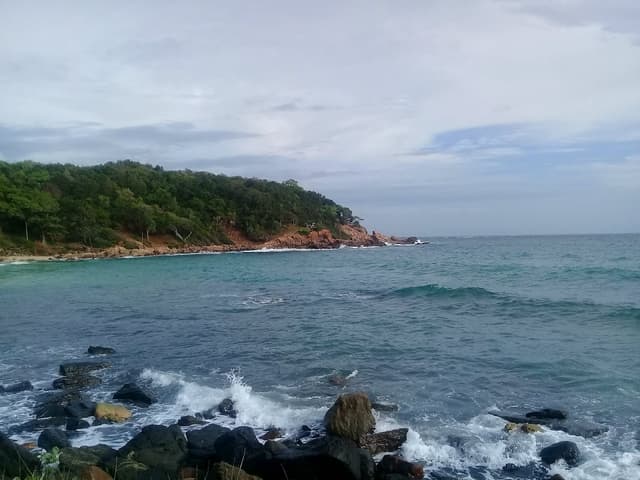
Green Bay Beach
@ravinkavish
Add to
Details

Stone cave
@ravinkavish
Add to
Details

Naval Museum
@ravinkavish
Add to
Details

Marble Beach
@ravinkavish
Add to
Details

Sampur Lighthouse | Foul Point Lighthouse
@ravinkavish
Add to
Details

Wilgamwehera Rajamaha Viharaya (Mahamevnawa Buddhist Monastery)
@ravinkavish
Add to
Details

Central Bus Station - Trincomalee
@ravinkavish
Add to
Details

Jaffna
@ravinkavish
Add to
Details

Dutch Fort - Jaffna
@ravinkavish
Add to
Details

Jaffna Public Library
@ravinkavish
Add to
Details

Jaffna Archeological Museum
@ravinkavish
Add to
Details

Nallur Kandaswamy Devasthanam
@ravinkavish
Add to
Details

Inuvil Kanthaswamy Kovil
@ravinkavish
Add to
Details

Kankesanthurai Lighthouse
@ravinkavish
Add to
Details

Keerimalai Naguleswaram temple
@ravinkavish
Add to
Details

Dambakolapatuna Sangamiththa Temple
@ravinkavish
Add to
Details

Casuarina Beach
@ravinkavish
Add to
Details

Kovalam light house | கோவளம் வெளிச்ச வீடு
@ravinkavish
Add to
Details

Fort Hammenhiel
@ravinkavish
Add to
Details

Delft National Park
@ravinkavish
Add to
Details

Queen's Tower - Delft Island
@ravinkavish
Add to
Details

Vediyarasan Fort
@ravinkavish
Add to
Details

Dutch Fort - Delft Island
@ravinkavish
Add to
Details

Jaffna Divisional Secretariat Bus Stop
@ravinkavish
Add to
Details

Jaffna Railway Station
@ravinkavish
Add to
Details
* * *
ABOUT THE AUTHOR
Solo Travel Guide Sri Lanka
Hi there! I’m Ravin from Sri Lanka.
As a solo traveler and a Travel Designer, I’ve explored this beautiful island, and while I often travel solo, I’ve made a lot of amazing connection with other solo travelers from all around the world. They always filled my journey with a lot of good vibes and memories.
However, I noticed that many solo travelers miss out on the true magic of Sri Lanka. And they also end up taking back-and-forth routes or miss hidden gems that could’ve made their trip much more epic. So I decided to design itineraries especially for solo travelers like you. My goal is to help you explore smarter, see more, save more, explore more and experience Sri Lanka with ease. No guesswork, no missed spots, just a well-planned adventure filled with discovery and excitement.
Here’s the best part: I’m giving these itineraries away for free! It’s my way of supporting you, Sri Lanka’s tourism, local communities, and businesses. Every itinerary I share is a result of my own journeys, insights, research, experience and information and support i received from my fellow travel buddies.
So, let’s make your trip to Sri Lanka something truly special. I’m here to guide you every step of the way!"
Send A Tip
Support Solo Travel Guide Sri Lanka’s work.
Select your tip amount
$5
$10
$20
$50
Or type in other amount
Explore related destinations
Read more about places in this guide
Powered by Thatch
The home for unique & authentic travel
The home for unique & authentic travel
Powered by Thatch: Where great trips are made.
© Solo Travel Guide Sri Lanka 2025 • Help • Privacy • Terms • Copyright • Become a Seller • Seller Academy • About • Careers • Blog • Explore Places
Ask ThatchGPT
Ask ThatchGPT
Suggest a local expert to plan my trip
Suggest an unique itinerary for my Srí Lanka, Sri Lanka trip
What foods do Srí Lanka, Sri Lanka locals eat
What are some true hidden gems in Srí Lanka, Sri Lanka
Help me brainstorm trip ideas for Srí Lanka, Sri Lanka
Help me plan a family-friendly trip to Srí Lanka, Sri Lanka